
Universe Sandbox Roadmap: 2024 & Beyond
Mar 18th
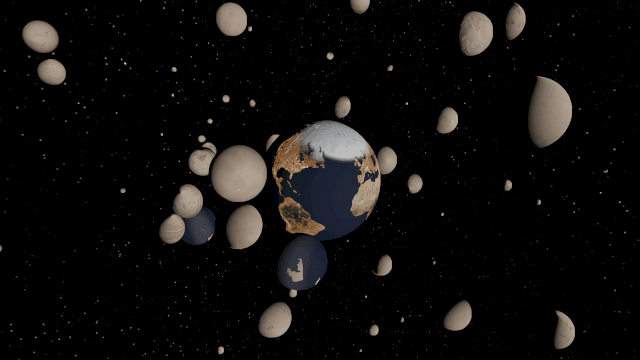
This year’s plans include a major graphics overhaul, more realistic collisions & craters, and putting Universe Sandbox on mobile devices so you can create and destroy on the go. Before getting into the details, here’s a brief recap of last year.
Highlights from 2023
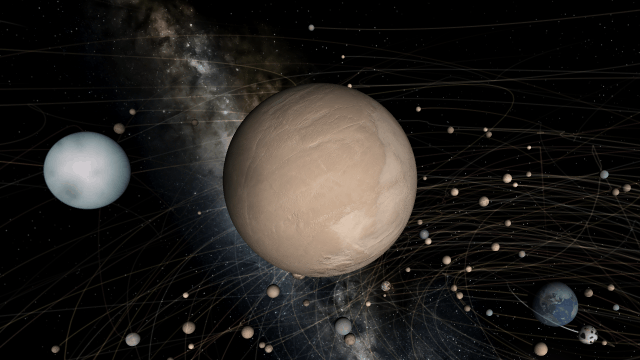
In 2023, we put out 4 feature-packed updates. Some of our favorite new additions include
- Massive improvements to our gravity simulation’s accuracy, stability, and performance.
- Adding 8 new materials, including oxygen & carbon dioxide, to realistically simulate, construct, and terraform planets and atmospheres.
- Rolling a Spherical Cow into Universe Sandbox. This refers to a joke that physicists sometimes oversimplify real-world problems to make them easier to solve.
The gravity simulation improvements and additional materials were major milestones from our 2023 Roadmap post. Check out our 2023 Retrospective post for more on what we did last year.
What’s the Plan for 2024?
- Using a new graphics renderer to immerse you further in the universe with bright glows, smoothly drifting dust clouds, and more.
- Optimizing our simulation performance with Unity’s Data-Oriented Technology Stack (DOTS).
- Doubling down on our efforts to bring Universe Sandbox to phones and tablets (iOS & Android).
- Begin adding basic plant-based life simulation.
- Continue improving our development tools to find and fix issues quickly.
We plan to work on all of these projects in 2024, but some, like our new graphics renderer, have been in the works for a while. Additional challenges may arise that delay features, and our priorities may change.
New Graphics: A Visual Glow-Up
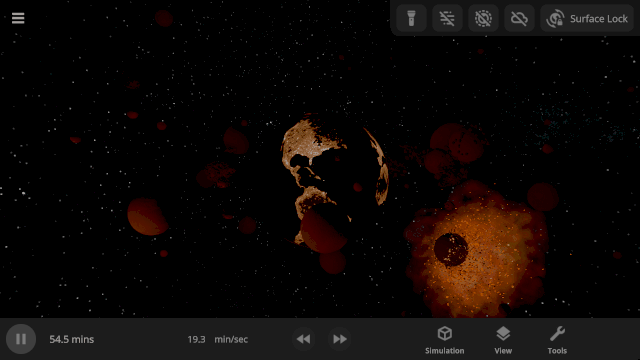
It’s time for a glow-up, literally. We’re rebuilding our graphics rendering from the ground up. After our overhaul, only the hot parts of the objects will glow instead of the entire object, dust clouds will blend smoothly with other objects, and more.
- New Graphics Renderer
- Last year, we started transitioning our graphics rendering to Unity’s Universal Render Pipeline (URP). This system allows us to use more true-to-life light properties and easily add and maintain new graphical elements. We’re expecting a performance boost too.
- Dust clouds passing through planets currently show sharp lines at their intersection. URP will let us render transparent clouds that blend smoothly with planets, called soft particles.
- Last year, we started transitioning our graphics rendering to Unity’s Universal Render Pipeline (URP). This system allows us to use more true-to-life light properties and easily add and maintain new graphical elements. We’re expecting a performance boost too.
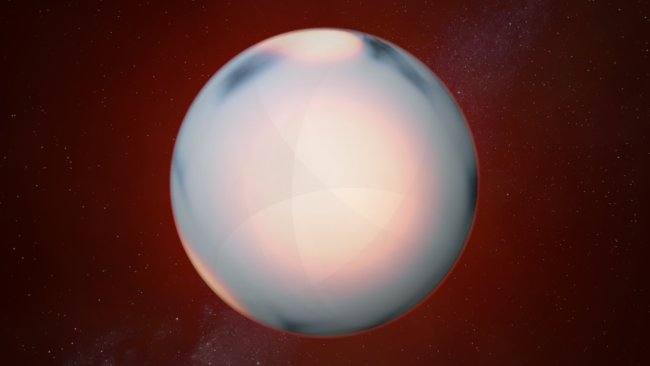
- Planets will glow only where their surfaces are hot, with hot spots from lasers and colliding objects only glowing at the impact site. Currently, planets glow uniformly based on their average temperature.
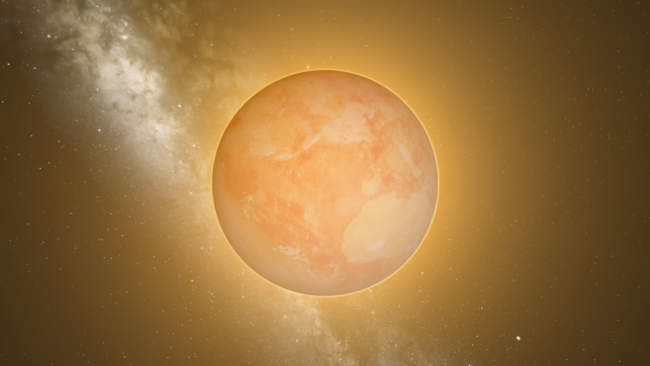
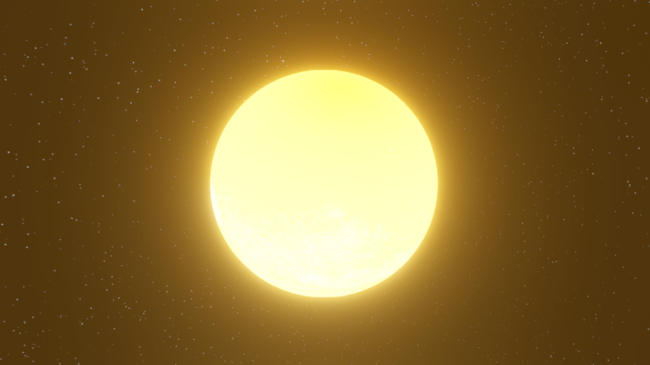
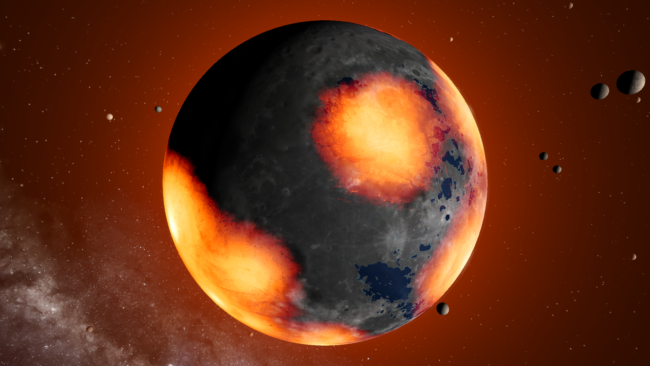
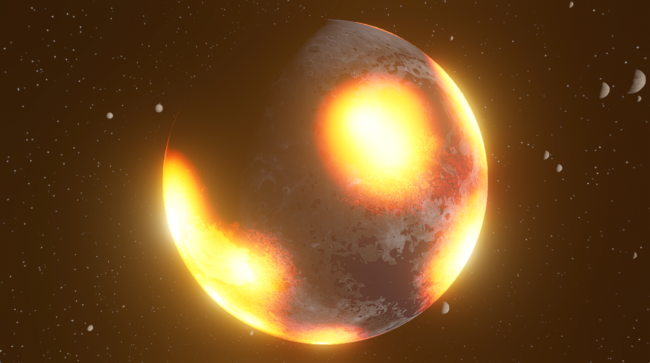
- Eventually, we’ll simulate objects casting shadows on themselves, like the solar panels on a spacecraft casting a shadow on its body.
- Lighting Up Space
- Light – it’s not just for stars anymore. Hot planets will emit light based on their temperature so you can light up your simulation with intense impacts.
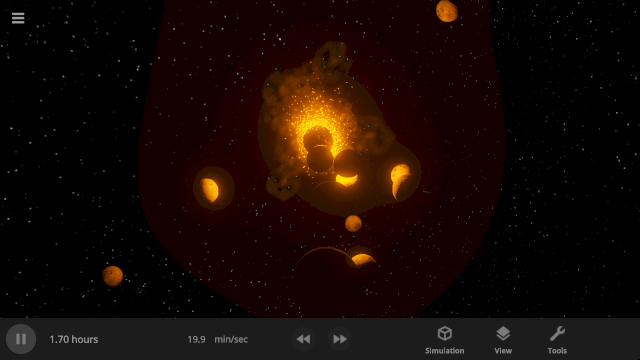
Physics: Collisions, Gravity, & Performance (Oh My)
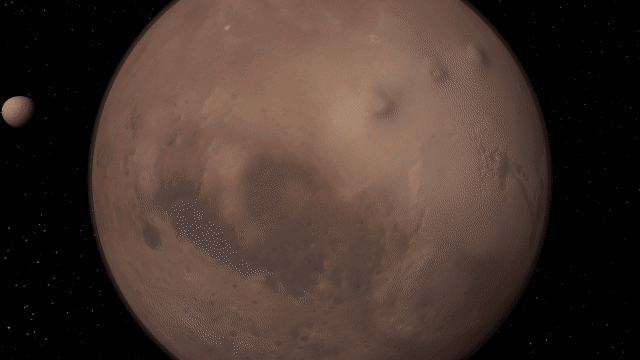
Improving collisions and their aftermath, like impact craters and ejecta, and continuing to optimize our physics simulation are all improvements we’re working on this year.
- Advanced Game Engine Features
- We’re continuing to reconstruct our simulation architecture using the Data-Oriented Technology Stack (DOTS) from Unity, the game engine we use to build Universe Sandbox. We made good progress last year and are excited about the expected performance gains.
- DOTS optimizes our simulation by efficiently running more computations simultaneously on the CPU, which means simulating more objects, collisions, and fragments at once.
- This transition will effectively combine parts of our simulation, like how different types of objects are defined, making it easier to maintain without sacrificing complexity.
- We’re continuing to reconstruct our simulation architecture using the Data-Oriented Technology Stack (DOTS) from Unity, the game engine we use to build Universe Sandbox. We made good progress last year and are excited about the expected performance gains.
- Grinding to a Halt
- Our new friction model will simulate craters stretching out as objects skid across each other’s surfaces during collisions. In our current simplistic model, craters are always circular.
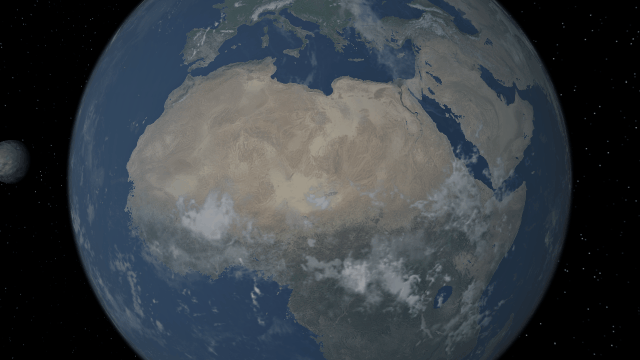
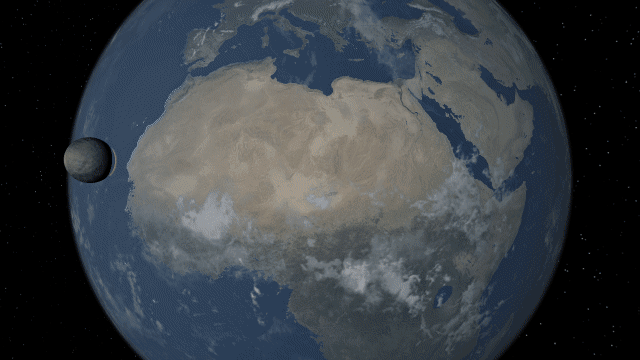
- To simulate meteors, we’re working on adding a drag force so objects burn up while traveling through a planet’s atmosphere. We’re also exploring ways to apply this force to objects passing through gas clouds and liquids. Currently, objects pass through atmospheres unchanged.
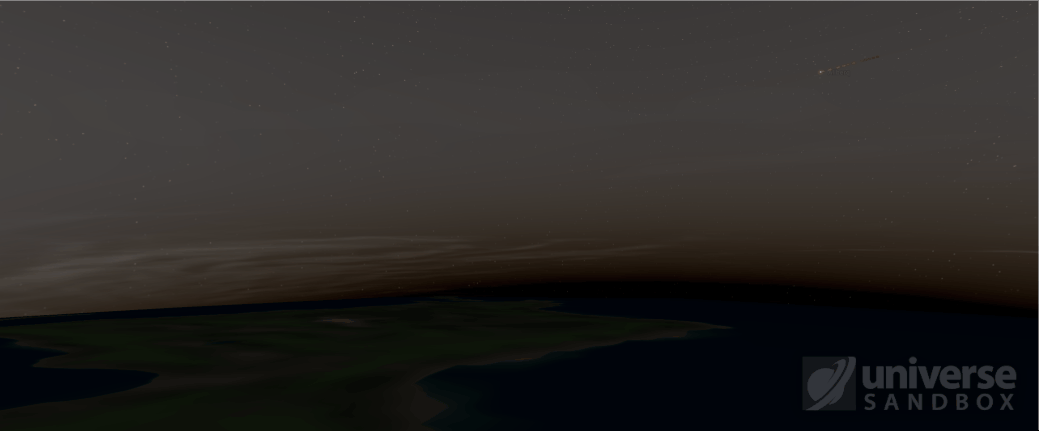
- Chaotic Consequences
- Rock fragments and gas clouds are created when planets collide or are vaporized, but computer limitations mean we sometimes need to remove the old ones to create new ones. We’re testing better removal methods to immerse you in the chaos. This was released in March as part of Update 34.1.
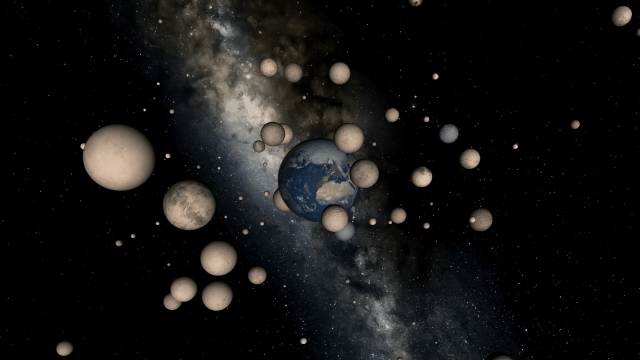
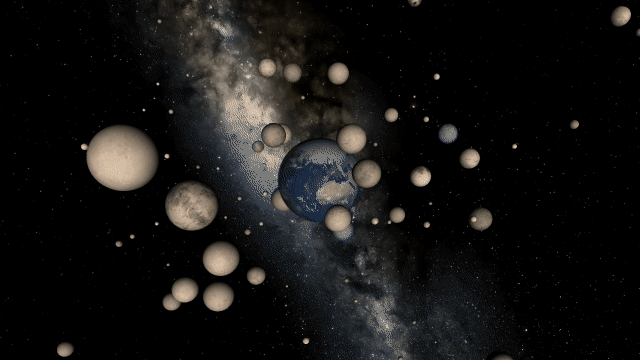
- New Gravity Simulation
- We’re experimenting with a new method of gravity simulation to allow rock fragments and dust clouds to attract and merge, forming planets & moons. Currently, these particles can only be pulled on and cannot form planets independently.
- We’re experimenting with a new method of gravity simulation to allow rock fragments and dust clouds to attract and merge, forming planets & moons. Currently, these particles can only be pulled on and cannot form planets independently.
- Smooth Object Transitions
- If the Sun gets too massive in Universe Sandbox, it instantly shrinks into a black hole. In real life, this shrinking and compression takes time. We’re updating our simulation so these transitions can occur on realistic timescales.
- We hope to simulate the answer to the question, “What if you filled the Solar System with soup out to Jupiter?” (Spoiler: The soup would contract into a supermassive black hole in about 30 minutes.)
- If the Sun gets too massive in Universe Sandbox, it instantly shrinks into a black hole. In real life, this shrinking and compression takes time. We’re updating our simulation so these transitions can occur on realistic timescales.
Universe Sandbox on Phones & Tablets
Getting Universe Sandbox on mobile devices (iOS & Android) is a major focus. We’re continuing to optimize our interface for small touch screens, and you can read about the latest mobile developments in our second Mobile DevLog.
- Small Screen Interface
- Unity’s cross-platform capabilities let us easily bring the same simulation changes to mobile devices and desktops.
- Our biggest challenge with mobile development is adapting our interface to work well on small touch screens (like a phone). Development is underway to intelligently resize, hide, and reveal panels as needed so you can focus on cosmic creation instead of managing the user interface.
- Unity’s cross-platform capabilities let us easily bring the same simulation changes to mobile devices and desktops.
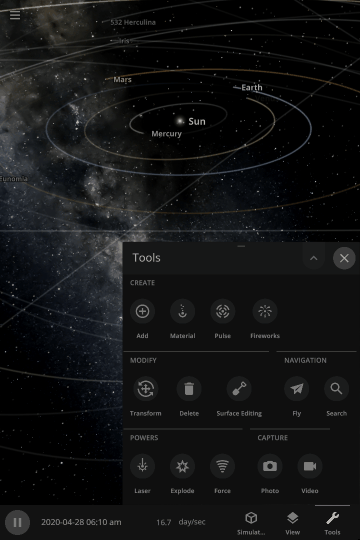
- Running a Universe
- Another requirement for mobile is boosting performance across all platforms. Alongside our new graphics renderer and rebuilding our simulation architecture, we’re improving interface responsiveness and resource utilization and optimizing start-up times, among other things.
- Another requirement for mobile is boosting performance across all platforms. Alongside our new graphics renderer and rebuilding our simulation architecture, we’re improving interface responsiveness and resource utilization and optimizing start-up times, among other things.
- More Information
- Universe Sandbox on mobile is built from the same codebase as the desktop version and will have the same features.
- There is no mobile release date yet.
- We plan on it being a one-time paid app with no ads or in-game purchases.
- Price is not finalized.
- Minimum requirements are not finalized.
- Sign up for our mobile mailing list to receive updates about mobile development
http://universesandbox.com/mobile/
Surface Simulation: Let There Be Life
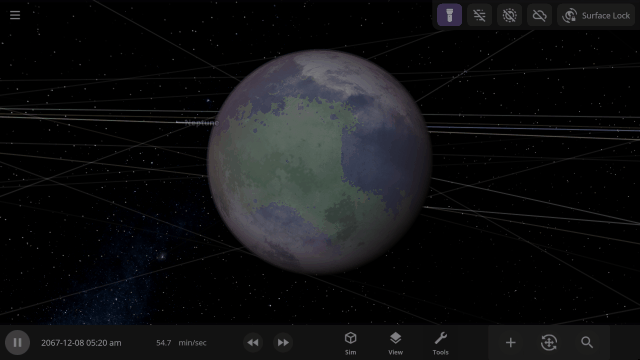
Now that we’re simulating materials like oxygen and carbon dioxide on planet surfaces, we can begin working on basic life simulation. Life will grow (and die) on these surfaces in real-time, the same way we simulate temperature, liquids, and gasses flowing.
- Basic Beginnings
- Initially, we plan to simulate just plant life, with vegetation growing, spreading, and dying based on the planet’s temperature, atmosphere pressure and composition, and more.
- As life develops, we’ll simulate how it affects the oxygen and carbon dioxide in the atmosphere, also known as a biosignature.
- Initially, we plan to simulate just plant life, with vegetation growing, spreading, and dying based on the planet’s temperature, atmosphere pressure and composition, and more.
- An Evolving Model
- Long term, we plan to add more varieties of life, like herbivores and carnivores, and simulate their interactions as a food chain develops.
- Eventually, you’ll be able to cause catastrophic events leading to mass extinctions and customize life conditions, like the amount of oxygen required for life to develop.
- Life will spread across planets’ surfaces after being Planetscaped onto a planet or appearing spontaneously. It will even spread to other planets on fragments from collisions.
- Long term, we plan to add more varieties of life, like herbivores and carnivores, and simulate their interactions as a food chain develops.
Upgrading Our Developer Toolkit
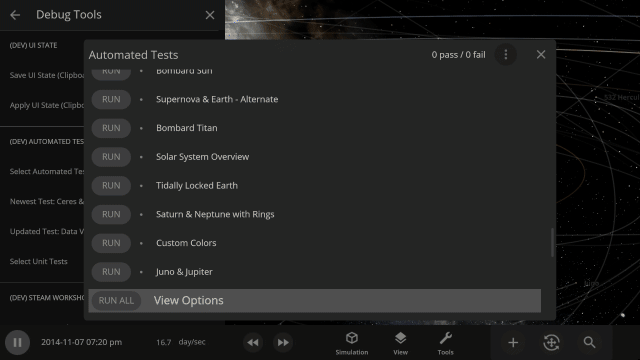
We’ve also been improving the tools we use to create and test Universe Sandbox for faster updates and bug fixing.
- Parallel Sandbox Construction
- Our newest automatic build system, which creates a new version of Universe Sandbox in the cloud whenever one of our team members changes the code, can make up to 10 versions at once.
- When many of us are making changes, this automation lets us test any new version within 30 minutes.
- When many of us are making changes, this automation lets us test any new version within 30 minutes.
- Each store that sells Universe Sandbox has slightly different requirements, so making multiple versions at once lets us release new updates almost simultaneously to all stores, like Steam and Epic. This process previously took a few hours.
- This new system will also create and deploy Universe Sandbox to mobile devices for testing on phones and tablets (iOS and Android).
- Our newest automatic build system, which creates a new version of Universe Sandbox in the cloud whenever one of our team members changes the code, can make up to 10 versions at once.

- Automation
- Expanding our automated test suite, which covers collision physics, simulation performance, and more, helps us catch and fix bugs faster.
- We’re exploring programmatic ways to compare test results to accelerate issue identification.
- We’re exploring programmatic ways to compare test results to accelerate issue identification.
- Producing and capturing game trailers and screenshots entirely in-game with a single button lets us easily show off the latest developments, like our upcoming new graphics renderer. New screenshots generated this way are already on our Steam store page, and we’re planning to release our updated trailer as an in-game guide.
- Expanding our automated test suite, which covers collision physics, simulation performance, and more, helps us catch and fix bugs faster.
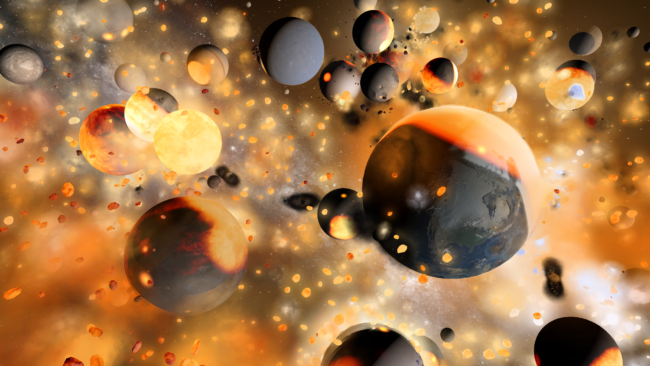
Updating Our Minimum Requirements
To adopt the latest technologies needed to restructure our simulation architecture and use our new graphics renderer, we plan to update our minimum requirements this year to include
- 4 GB dedicated video memory (up from 2 GB). 8 GB will be recommended.
- Apple: Silicon CPU (M1 or newer), meaning that Intel Mac will no longer be supported.
- Windows: Direct X version 12
While it is never fun to have support dropped, these new technologies will allow us to improve performance and add new features to Universe Sandbox now and well into the future.
We’ll ensure all users affected by this change can always access the version of Universe Sandbox from before this minimum requirements update.
And Beyond
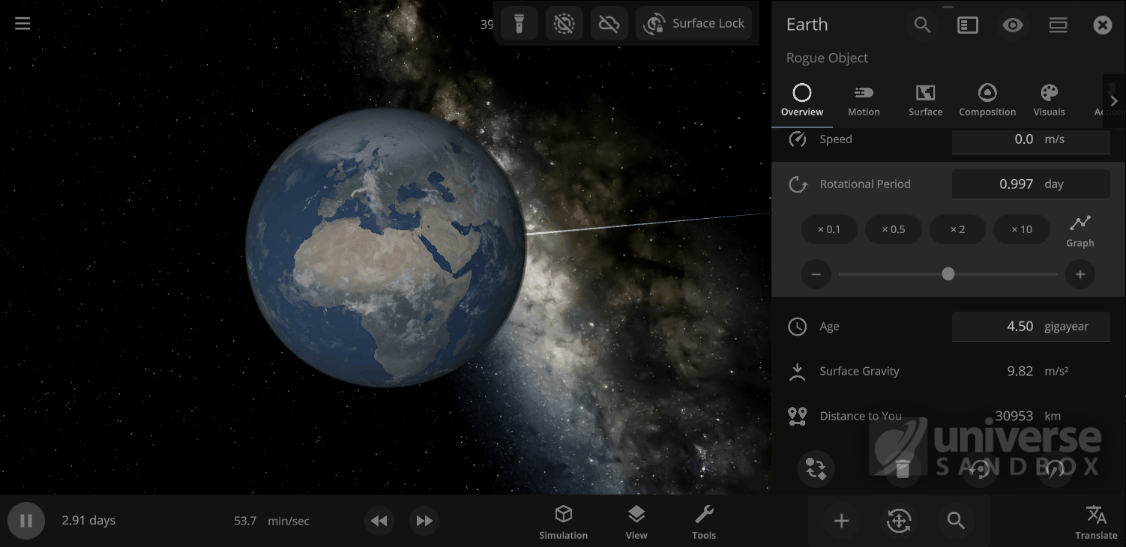
Our future goals include realistically colliding everyday objects, like a watermelon and a sledgehammer, adding detailed planet surfaces, and properly simulating comet tails. These are in early development, and we don’t know when they will be released.
- Stretch it Out
- Most objects in Universe Sandbox are spheres, but in real life, some rotate so quickly that they stretch and flatten, like the dwarf planet Haumea. We’re working to simulate that stretching.
- Most objects in Universe Sandbox are spheres, but in real life, some rotate so quickly that they stretch and flatten, like the dwarf planet Haumea. We’re working to simulate that stretching.
- Everyday Object Collisions
- Currently, when objects collide, they’re treated as spheres. We’re working on adding new physics so that everyday objects, including simple shapes like dice and complex shapes like spacecraft, will collide according to their unique forms. This is often known as rigid body collision physics.
- Currently, when objects collide, they’re treated as spheres. We’re working on adding new physics so that everyday objects, including simple shapes like dice and complex shapes like spacecraft, will collide according to their unique forms. This is often known as rigid body collision physics.
- Detailed Planet Surfaces
- Imagine flying over mountains and through canyons on planet surfaces in Universe Sandbox. We’re still experimenting with ways to add more details to planet surfaces, but we’re excited about the possibilities.
- Imagine flying over mountains and through canyons on planet surfaces in Universe Sandbox. We’re still experimenting with ways to add more details to planet surfaces, but we’re excited about the possibilities.
- Volatiles
- To simulate comet tails streaking through space, we plan to overhaul our volatile system, which determines how gas escapes from a planet’s atmosphere into space.
We’re excited to bring so much to Universe Sandbox this year, and we can’t wait to share it with you!

Eclipsed Improvements | Update 34.1
Mar 5th

If Update 34.1 does not download automatically, follow these update instructions. If you don’t own Universe Sandbox, you can buy it via our website.
2024 Total Solar Eclipse
Watch the Moon completely block out the Sun across parts of Mexico, the United States, and Canada in our simulation of the April 8, 2024 total solar eclipse. Check it out under:
Home > Open > Total Solar Eclipse on April 8, 2024
Learn more about this eclipse.
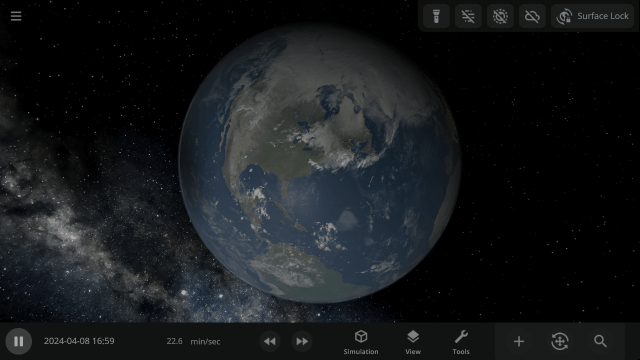
Chaotic Collisional Aftermath
Immerse yourself in chaos as gas clouds expand and rock fragments collide in the aftermath of collisions. We’ve updated our particle system to preserve performance while simulating fuller, more realistic collisions.
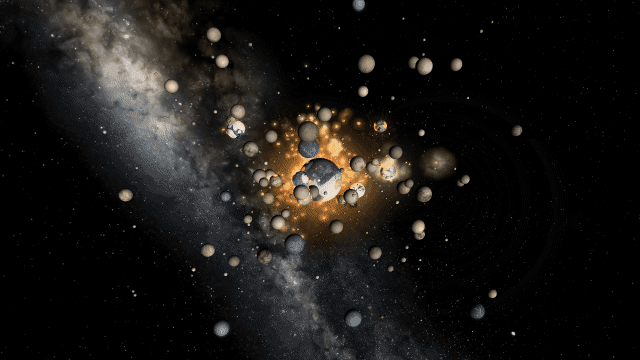

Custom Habitable Range
Customize the habitable temperature and atmospheric pressure of your planets for more unique vegetation and city lights coverage.
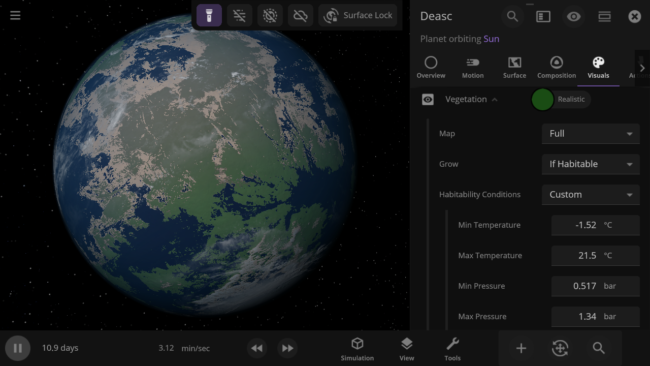
More Highlights
Explore the chaos of the fictional planetary system of Trisolaris from The Three-Body Problem. The number of objects gravitationally interacting makes it impossible to predict the planet’s orbits, called the three-body problem.

All gasses in a planet’s atmosphere now contribute to its color and opacity instead of just the 4 gasses with the most mass.

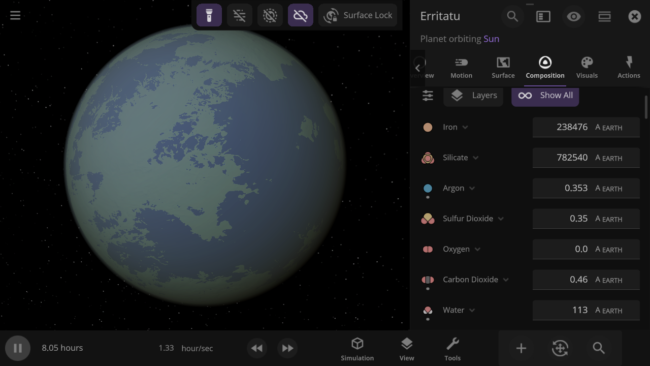
An object’s material composition now just shows the list of materials currently in the object by default. We’ve also added an Add New Materials button.
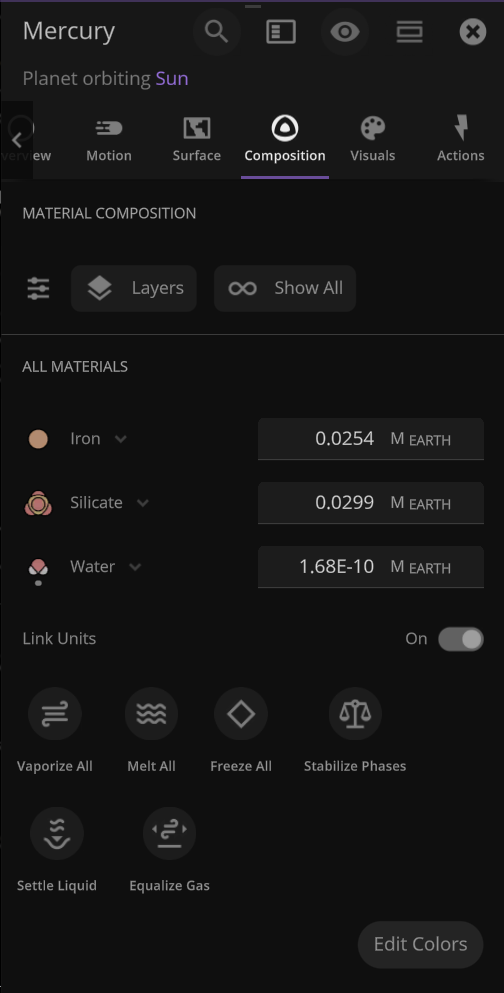
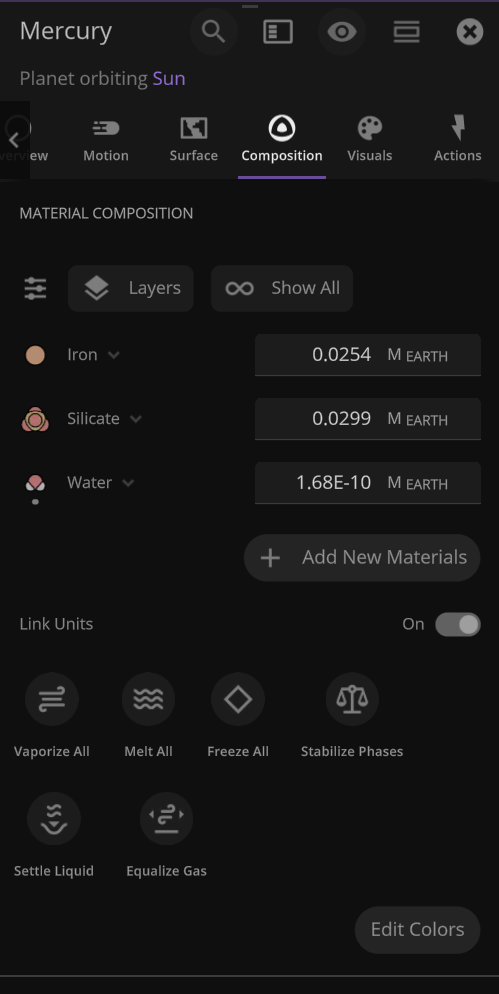
Use the new Hide Dust Clouds toggle to look at planet surfaces and see collisions through thick clouds of dust.
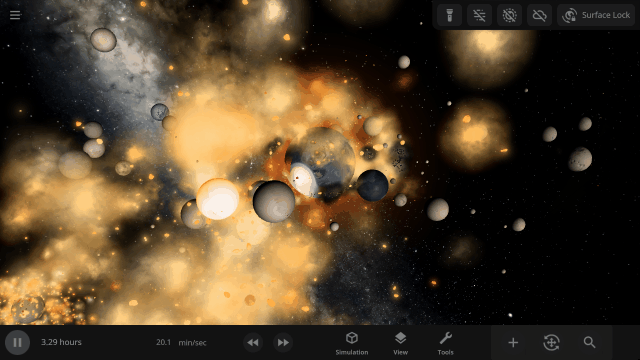
The object properties panel has been greatly optimized, making it faster to open and switch objects.
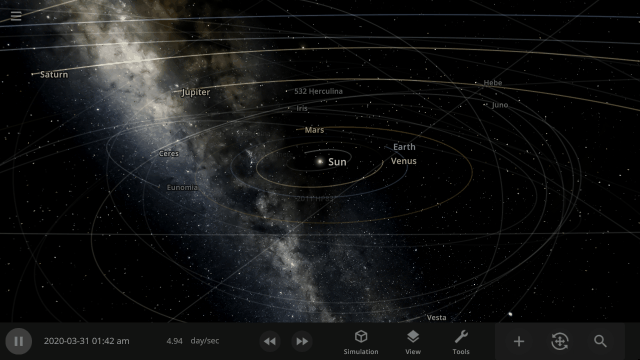
Completely swap one material on a planet for another with one tap. What would Earth look like if you switched out all the water for methane?
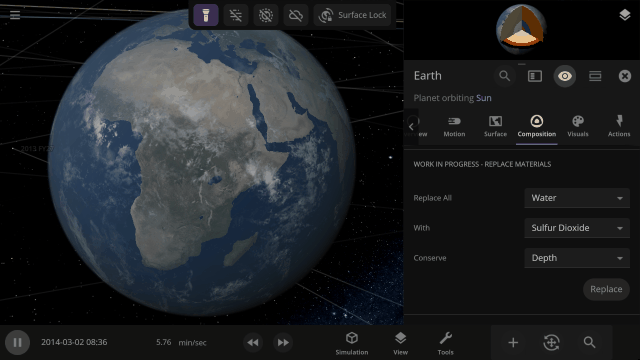
This update is brought to you by our completely new build system, which automatically creates different versions of Universe Sandbox whenever one of our team members updates the code it’s built on, allowing us to test and release new features even faster.
Listen to your favorite Universe Sandbox track over and over again by looping them under
Settings > Audio > Music Controls > Loop Track
Check out the full list of What’s New in Update 34.1
Please report any issues on our Steam forum, on Discord, or in-game via Home > Send Feedback.

Universe Sandbox 2023 Retrospective
Jan 24th
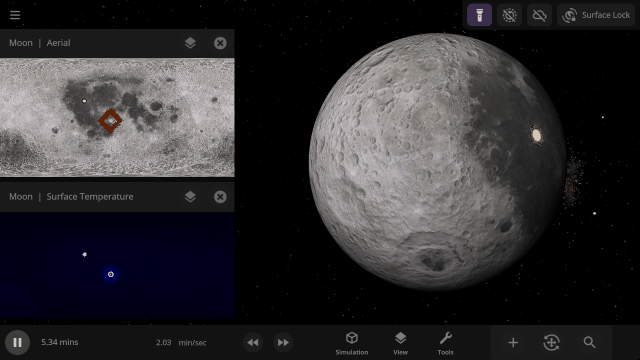
We’ve got a lot planned for 2024, including a massive graphics upgrade, collision and cratering improvements, getting Universe Sandbox on mobile devices (iOS & Android), and more! We’ll go into more exciting details in our upcoming 2024 Roadmap post, but first, let’s reflect on some achievements from 2023.
1
Spherical Cow
We added one new human-scale object last year – a spherical cow. A spherical cow refers to a joke that when physicists want to make a problem easier to handle, they sometimes simplify it so much it’s no longer realistic.
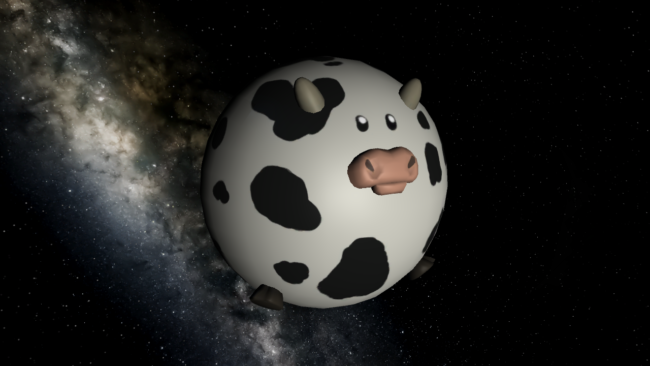
4
Significant updates to Universe Sandbox
- A Comet, an Asteroid, and a Planet Walk into the Solar System | Update 32.2 | March 2023
- Added a spherical cow and many simulations including the green comet C/2022 E3 (ZTF) passing by Earth.
- Grand Collision Unification | Update 32.3 | June 2023
- Combined our two previous collision models for more realistic shockwaves, heating, and overall destruction.
- Gravity Simulation Upgrade | Update 33 | August 2023
- Overhauled our gravity simulation to increase accuracy, stability, and performance to run simulations even faster.
- Terraforming | Update 34 | December 2023
- Added 8 new materials (for a total of 12), including oxygen and carbon dioxide, to realistically simulate, construct, and terraform planets and atmospheres.
- Finally simulating the lakes of liquid methane on Titan.
The Gravity Simulation Upgrade and Terraforming were major milestones from our 2023 Roadmap post.
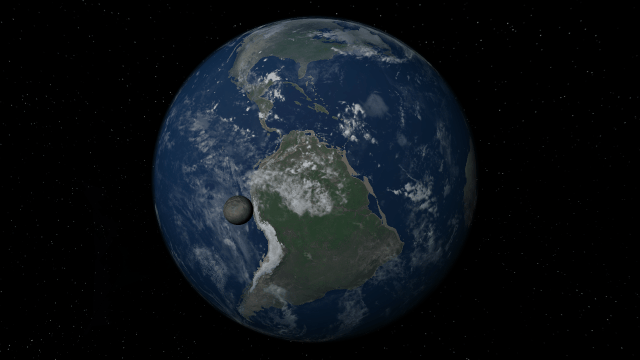
8
New materials
We added
- Helium
- Carbon dioxide
- Oxygen
- Sulfur dioxide
- Methane
- Nitrogen
- Argon
- Ammonia
Alongside the existing materials, silicate, iron, hydrogen, and water to Universe Sandbox. Now you can terraform planets and simulate atmospheres more realistically than ever.
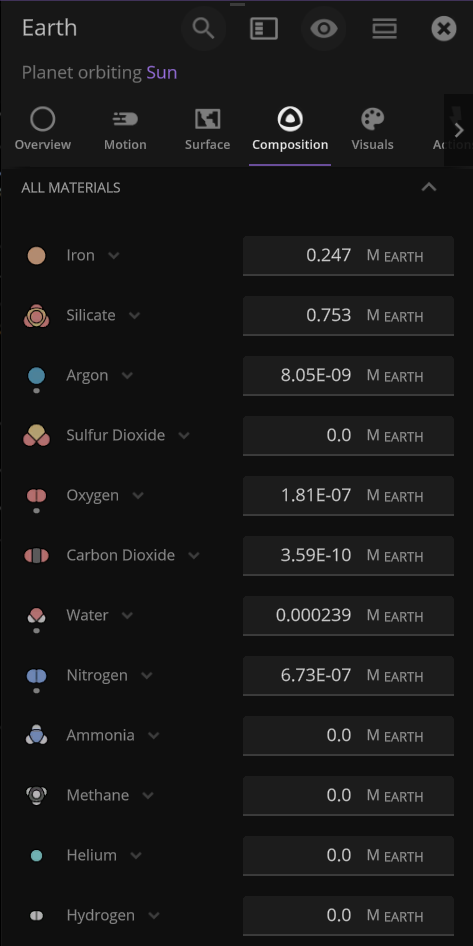
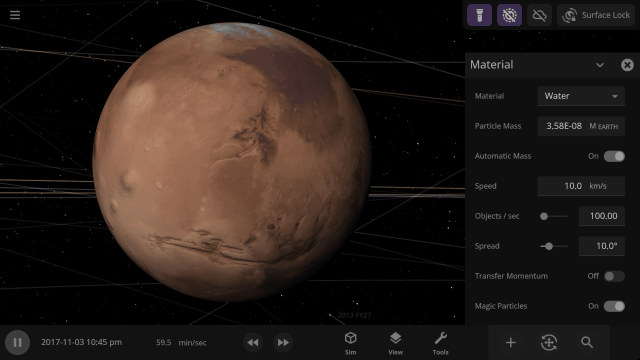
36
New simulations and guides added to Universe Sandbox
Check out the 31 new simulations, including the Bombard Moon with Materials (below), and 5 new guides, including Terraforming Mars and Searching for Supermassive Black Holes, under
Home > Open
and
Home > Guides
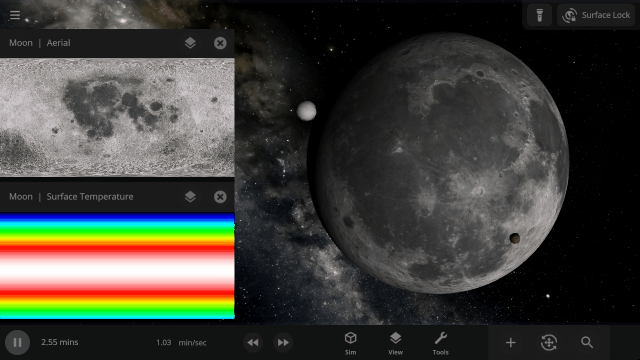
727
Highest number of concurrent users in Universe Sandbox
Easily surpassing the previous highest number of 648 on December 24, 2021. January 30, 2023 must have been a great day to cause celestial havoc.
2,336
Positive Steam reviews in 2023
We’re truly amazed and humbled that we are rated “Overwhelmingly Positive,” both recently and all-time on Steam. Over 96% of all reviews we’ve received are positive.
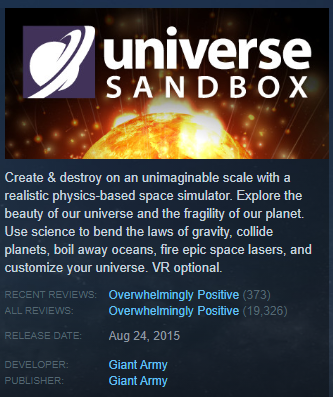
2,405
New code commits, or changes, made to Universe Sandbox through GitHub, the platform we use to maintain and manage our code
The most code commits occurred during the week of December 3, right before Terraforming | Update 34 was released, with 87 commits. A single commit can be a simple typo correction or a whole new feature

9,757
Discord users on our server
It’s great to see your constructive discussion and creations on our server, which has grown by almost 20% in the last year. 10,000 is so close, let’s hit 12,000 this year! Join us on Discord.
15,747
Simulations shared in the Universe Sandbox Steam Workshop in 2023
That’s more than 43 simulations shared every single day! There are over 50,000 total simulations shared on the Steam Workshop for you to explore and be inspired by.
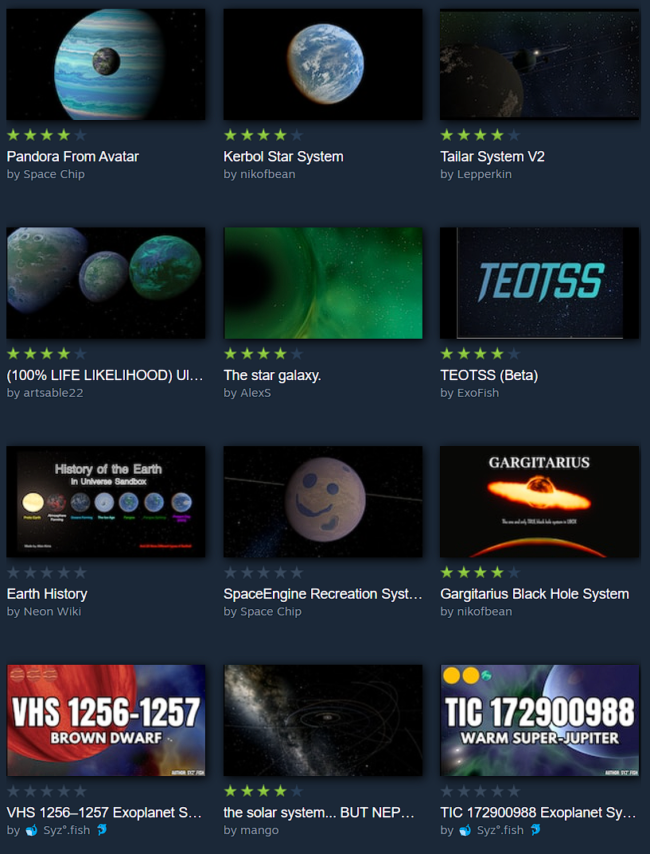
25,326
Files uploaded on our team messaging app, Slack, in 2023
That’s more than 3 times as many as last year, including screenshots and videos of features in progress, log files for resolving issues, and images of bugs, like those below.
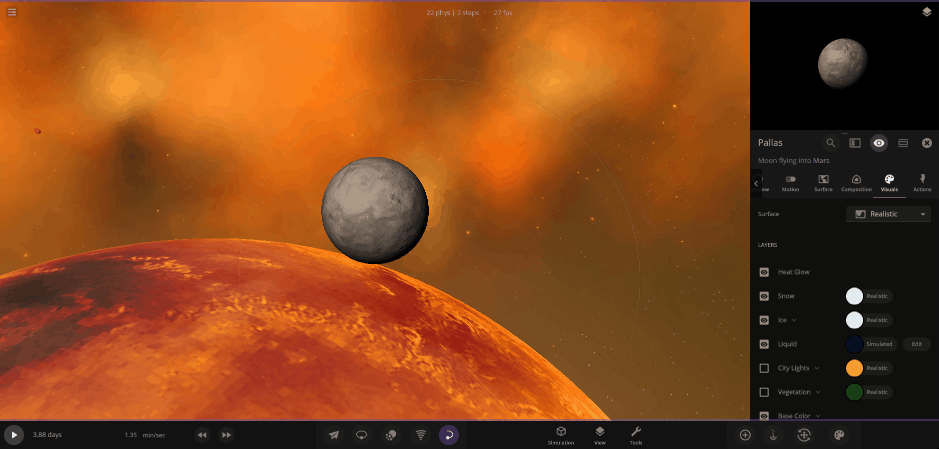
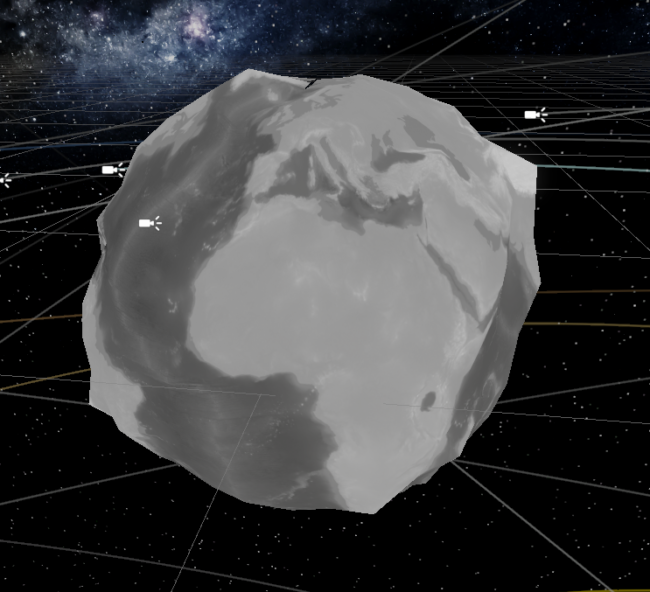
56,466
Messages sent on Slack in 2023
Giant Army has been entirely remote since its founding in 2011, and with 13 team members across 4 continents and 6 time zones, messaging on Slack is how we get most of our work done.
592,638*
Times the ‘Welcome to Universe Sandbox’ guide was played in 2023
Whether you’re a new player or just wanted a refresher, we hope you enjoyed learning about the beauty of our universe. And how to destroy it.
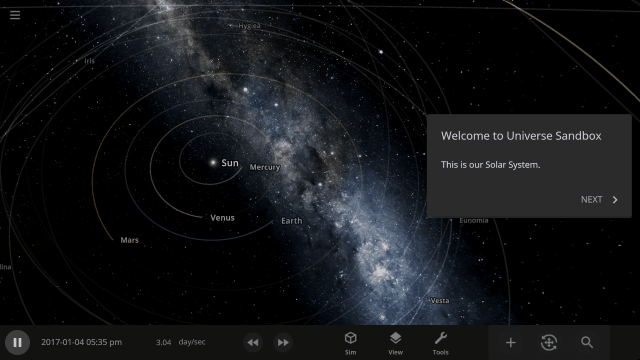
1,005,262*
Times the Planetscaping tool was used in 2023
The Planetscaping tool became even more powerful with the ability to add individual materials. Seeing the passion and attention to detail you all put into customizing planets is fantastic.
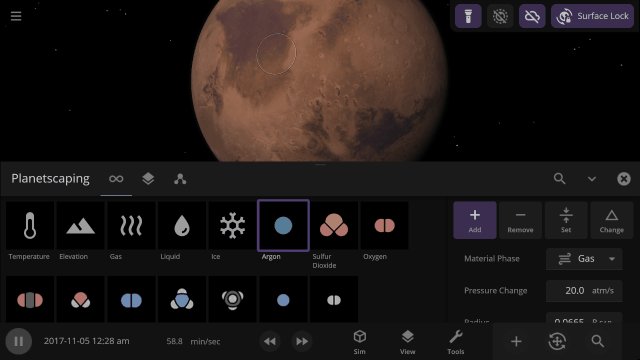
1,380,778*
Times supernovas went off in Universe Sandbox in 2023
Astronomers estimate there will be 1 supernova in the Milky Way every 100 years. They also think there are about 100 billion galaxies in the universe. Assuming all galaxies have a similar number of supernovas, about a billion occur each year.
We got about 1% of the way there in 2023. Turns out that even with everybody working together, recreating everything happening in the universe is hard.
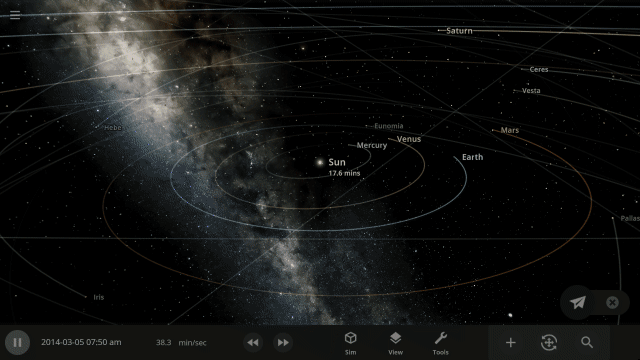
6,265,426*
New simulations created in Universe Sandbox in 2023
That’s about one new simulation created every 5 seconds.
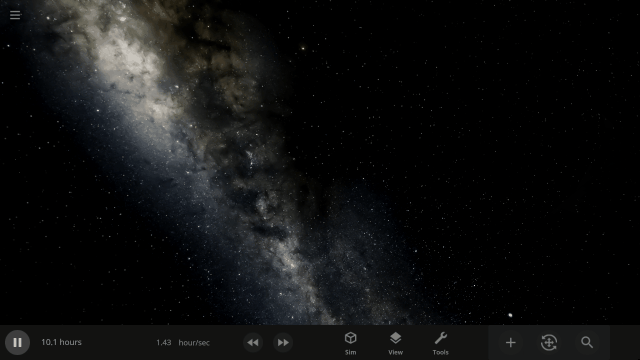
31,394,000+
Views of Universe Sandbox videos and shorts on YouTube
Getting an exact view count of every YouTube video that featured Universe Sandbox in 2023 is almost impossible, but we think this is a reasonable estimate (the actual number is larger). We appreciate every video posted and are glad so many people enjoy them!
Check out two of our most prolific YouTubers, Space Chip and Neptunian Guy.
* Due to a change in our analytics system, we have extrapolated 2023’s numbers based on the total increase in player activity on Steam.
What’s Next?
We’re already working on a major graphics upgrade, getting Universe Sandbox on mobile devices (iOS and Android), overhauling the framework that Universe Sandbox is built on, and more! Be on the lookout for more details in our 2024 Roadmap post.
And Most Importantly
Thank you. All of your kind words, feedback, and excitement inspire us to continue our mission of creating a realistic, interactive simulation of the amazing universe we find ourselves in. We believe that giving people the power of unlimited creation and destruction is the best way to discover its awesomeness.
We’re able to keep improving Universe Sandbox year after year because of your support, and we are truly grateful. There is so much more we want to bring to Universe Sandbox, and we can’t wait to do it.
The Universe Sandbox Team
Dan, Chris, Georg, Jonathan, Rappo, Mat, Jacob, Erika, Brendan, Anders, Brent, Pavel, and Conrad

Universe Sandbox on GeForce NOW
Dec 21st
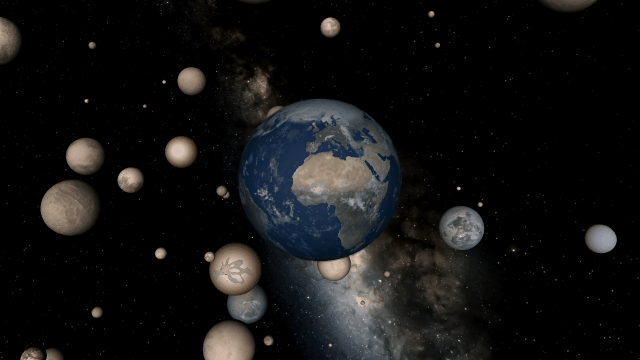
Universe Sandbox is now available to play on GeForce NOW, NVIDIA’s cloud-based game streaming service!
GeForce NOW connects to digital PC game stores like Steam so you can play games you already own in the cloud and stream them to any compatible device in real time.
Bend the laws of gravity, collide planets, boil away oceans, fire epic space lasers, and customize your universe in real time with cloud-based gaming streamed directly to any supported device. And check out our newest update to simulate, construct, and terraform planets and atmospheres more realistically than ever with new materials including oxygen and methane!
If you own Universe Sandbox on Steam, you can play Universe Sandbox on GeForce NOW by
- Launching GeForce NOW in your browser or downloading the GeForce NOW application
- Creating a free account (free accounts may have multi-hour waits before you are able to play. You can skip the queue with a paid account)
https://www.nvidia.com/en-us/geforce-now/memberships/ - Linking your Steam account
- Going to your Games library
- Playing Universe Sandbox
Learn more on NVIDIA’s GeForce NOW page.
Any saved simulations and objects you have will be accessible in GeForce NOW, and any saved simulations you create while playing through the service will be available after your session.
If you don’t own Universe Sandbox, you can buy it via our website or Steam.

Terraforming | Update 34
Dec 14th

If Update 34 does not download automatically, follow these update instructions. If you don’t own Universe Sandbox, you can buy it via our website.
Simulate, construct, and terraform planets and atmospheres more realistically than ever before with new materials! Planet sizes, atmospheric heating, gas and liquid colors, and more are now simulated based on the mass and phase of each material in a planet’s composition.
Learn more about how we simulate materials in two new guides
Home > Guides > Tutorials > Playing with Materials
Home > Guides > Science > Terraforming Mars
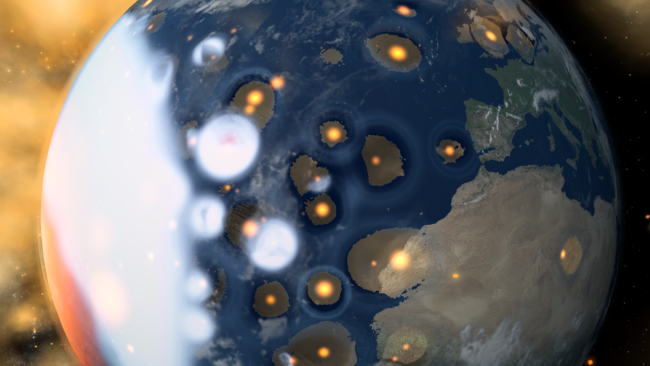
New Materials
Terraform planets, rain down oceans, and expand atmospheres with 8 new materials (for a total of 12) using the Material or Planetscaping tools, or adjust the materials directly under
Properties > Composition
In addition to silicate, iron, hydrogen, and water, we are now simulating helium, carbon dioxide, oxygen, sulfur dioxide, methane, nitrogen, argon, and ammonia.
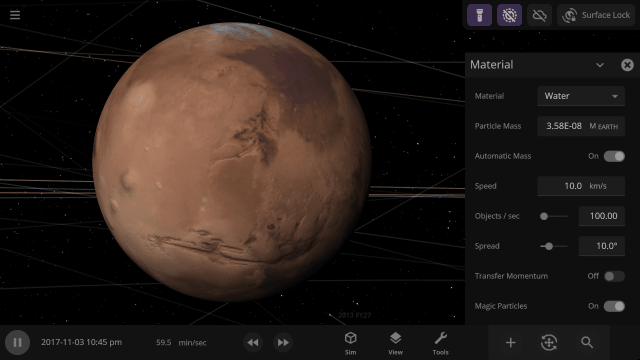
Planet Atmospheres
Create pleasant Earth-like or oppressive Venus-like atmospheres by adjusting the mix of materials in the atmosphere. Atmosphere colors are based on the amount of gas in a specific area, with thicker atmospheres being harder to see through.
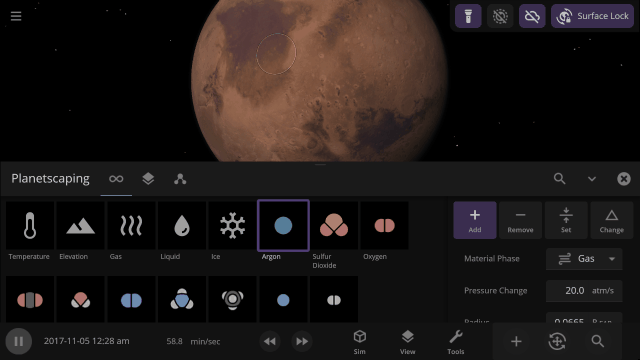
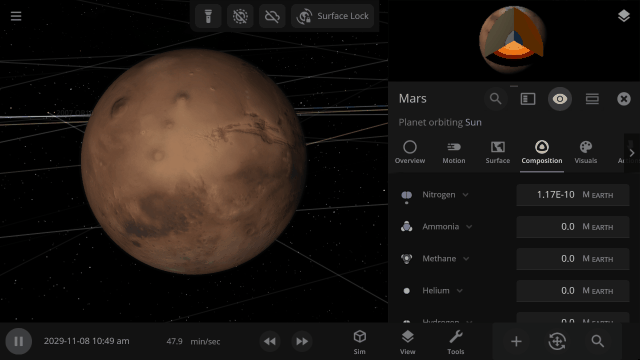
Material Collisions
Bombard planets with materials to see their atmospheres and oceans indefinitely altered. Watch oceans boil, creating vapor-filled atmospheres. Impacts create shockwaves that push gases and punch holes in the atmosphere.
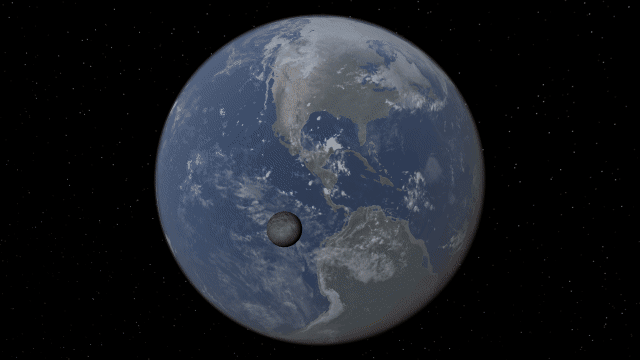
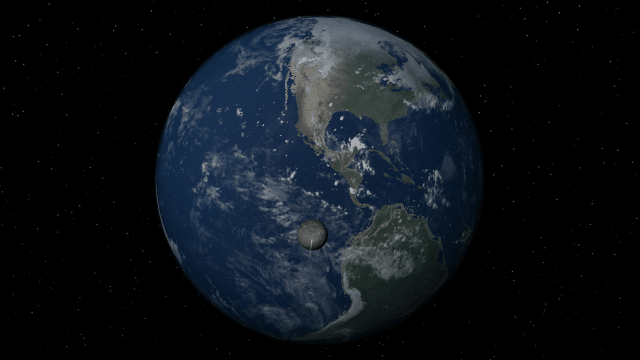
Object Size from Composition
We’re using complex models of materials under the intense heat and pressure inside planets to compute realistic planet sizes.
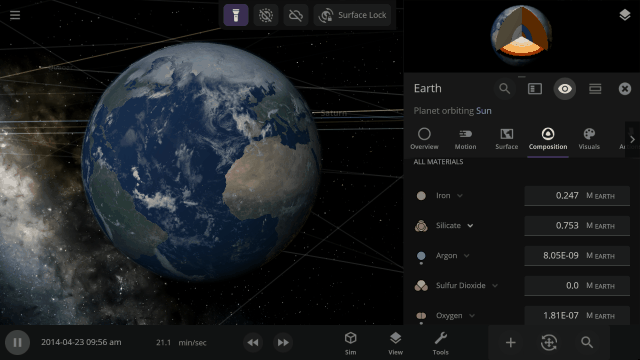
More Highlights
Material colors are based on their real-life properties. Materials blend on the surface of planets and moons so you can watch oceans and gas clouds mix in real time. You can also customize material colors under
View > Advanced View Settings > Materials

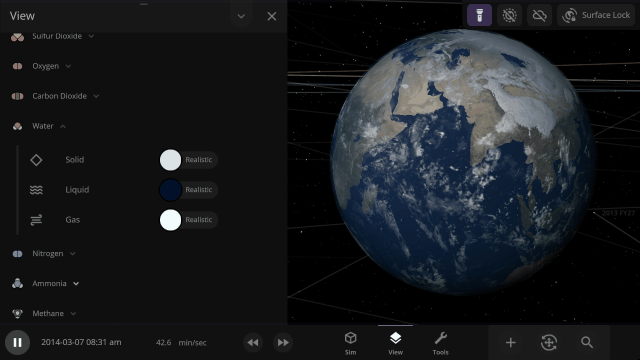
Adding materials beyond water allows us to simulate Titan’s methane lakes. In the future, these new materials will also be the foundation for simulating life.
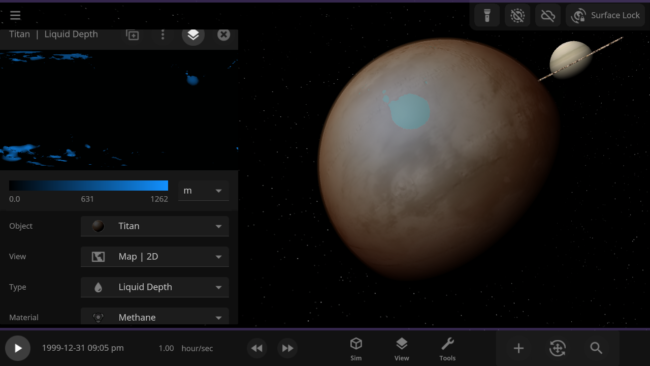
The 4 materials with the most mass will automatically be simulated across an object’s surface, indicated by a dot, similar to how water was simulated. You can also override this and choose any 4 materials to simulate across an object’s surface.
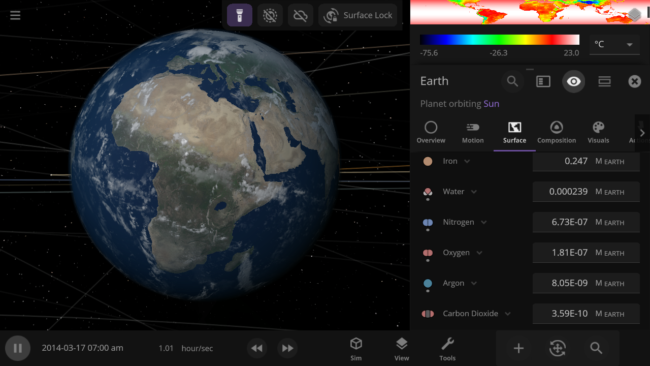
We’ve added a collection of material simulations so you can compare how they change phase between solid, liquid, and gas
Home > Open > Materials
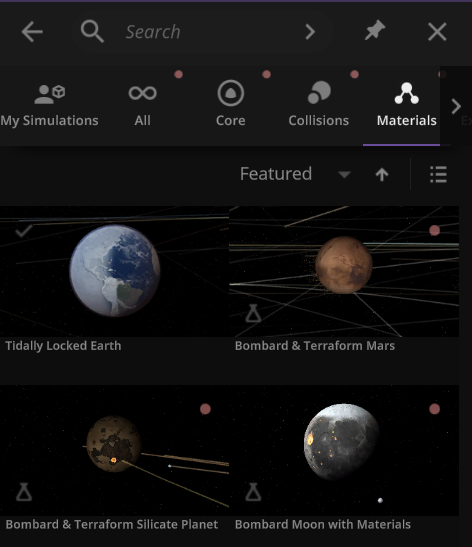
The simulation below shows Earth with different materials in each column and a different amount of that material as a liquid in each row. Some evaporate immediately, and some stay liquid under Earth-like conditions.
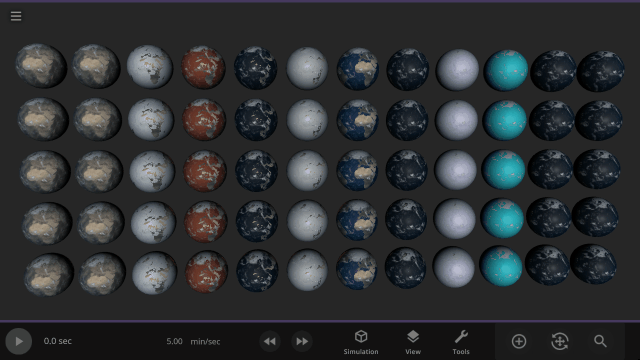
Easily change the atmospheres of custom planets, old and new, using atmosphere presets of known terrestrial planets. This interface is a work in progress.
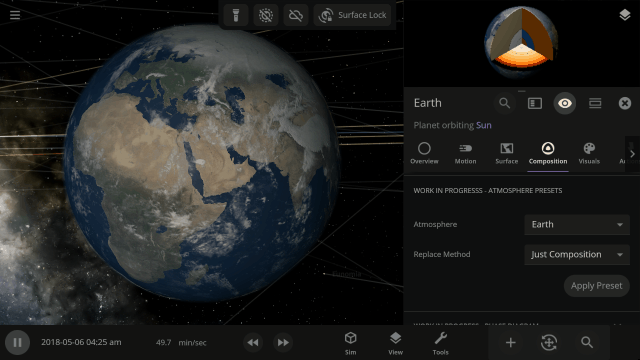
Materials masses can be viewed and adjusted by phase (solid, liquid, gas) or collectively at once under an object’s Composition.
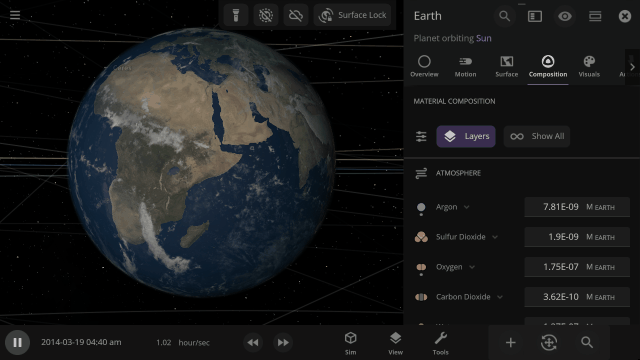
More accessible View toggles make it easy to turn on surface lock, illuminate the dark side of planets, or toggle the visibility of atmospheres and clouds.
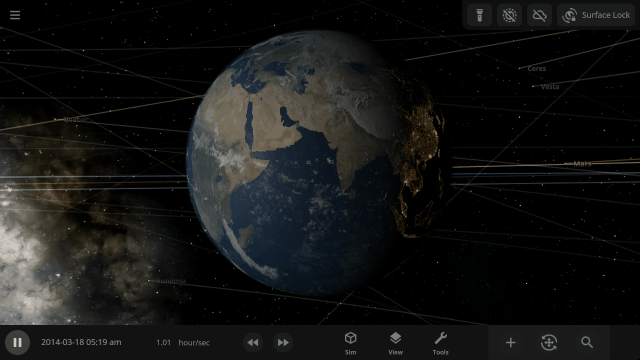
City Lights and Vegetation now require a habitable gas pressure of 0.6 to 1.6 bars and a new habitable temperature of -25 °C to 55 °C (previously -55 °C to 55 °C) and to appear when set to “If Habitable.”
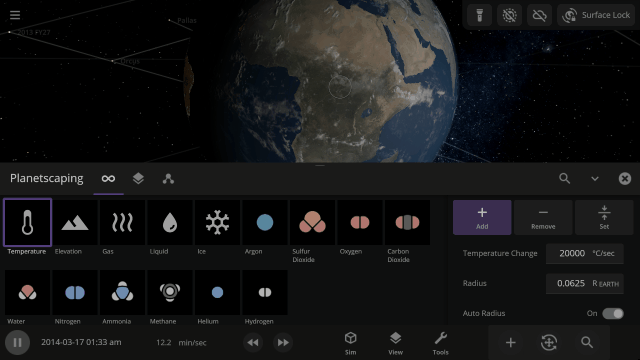
Use object Markers (formerly called Icons) to clearly see the position and movement of objects and particles in a simulation, like nebula in a galaxy, under
View > Markers
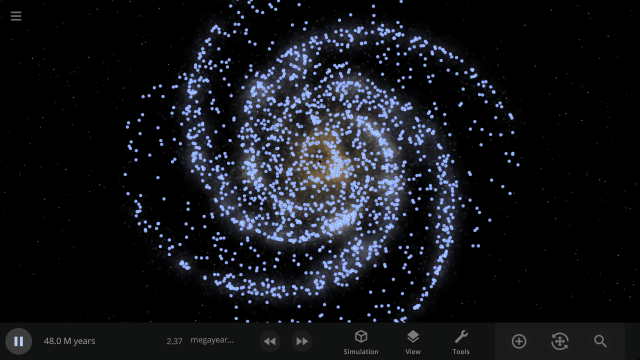
Check out the full list of What’s New in Update 34
Please report any issues on our Steam forum, on Discord, or in-game via Home > Send Feedback.
Known Limitations & Planned Improvements
- Only water vapor and gaseous carbon dioxide contribute to our simple atmospheric heating model. We plan to add heating from methane and other greenhouse gases in the future.
- Silicate and iron can only exist on the inside of a planet, not on the surface or in the atmosphere.
- To minimize the impact to performance, only a maximum of 4 materials can be simulated flowing across an object’s surface at a time. We plan to increase the number of materials simulated on object surfaces in the future.
- When a new material replaces one of the 4 simulated materials, it is evenly distributed over the surface, which can cause an atmosphere to seemingly “pop” into existence.
- Materials not simulated across the surface of objects do affect their atmospheric heating, but do not affect the atmosphere opacity.
- Planning updates to the materials interface, including:
- Viewing materials as a percentage of the mass
- Updated Phase Diagram interface
- Updated Atmosphere Preset selection interface
- Better explanation of the Composition cutaway view
- Add the ability to easily replace one material with another
- The maximum speed liquids and gases can flow across object surfaces is slower than the maximum speed of material phase changes and simulation speed.
- Computing planet radii from their composition does not take into account the object’s surface temperature (so heating a gas giant won’t make it expand, for example).
- Phase changes (like evaporation) do not affect the surface temperature of an object.
- Materials in small asteroids do not undergo phase changes.
- Materials transferred during collisions are currently always transferred in the liquid phase (although they can change phase quickly after being transferred).
- The color of Titan’s atmosphere is not fully simulated because they are caused by tiny amounts of organic particles called tholins that are not simulated in Universe Sandbox. We plan to simulate the colors of hazes like those in Titan’s atmosphere in the future.

Terraforming Preview | Adding More Materials to Universe Sandbox
Oct 24th

Our new composition system, including eight new materials, like oxygen and methane, is still in active development and has not been released, but you can opt-in to a preview version now on Steam. Every planet in Universe Sandbox is simulated with a combination of materials, like iron and water, that are used to compute properties like planet radius and water flow. However, our current composition system is too simple to simulate phenomena like lakes of liquid methane on Saturn’s moon Titan. Our new system will allow you to realistically simulate planet surfaces and atmospheres, accurately terraform planets, and more.
Try the Terraforming | Update 34 preview right now!
Eight new materials and our new composition system are now available for testing and feedback. Learn how to opt-in to a preview version on Steam:
https://universesandbox.com/support/previewversion
Material Properties in Universe Sandbox
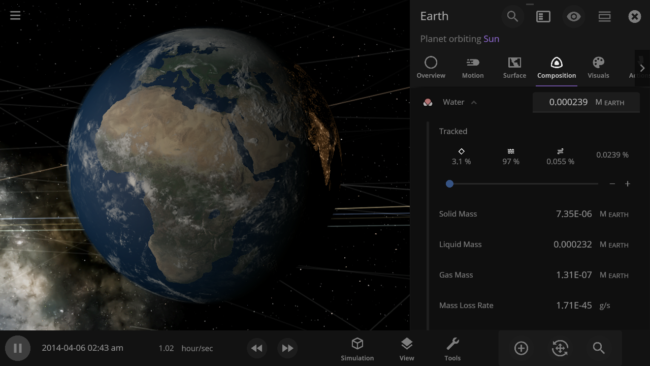
Current Composition System
Universe Sandbox’s current composition system uses four materials (iron, silicate, water, and hydrogen) each with a set of physical properties including
- Density – to compute an object’s mass and radius and determine where materials are within a planet (for example, iron is the densest so it’s at the core).
- Thermal capacity – energy required to increase the material’s temperature by one degree. Used to determine the Surface Heat Capacity of a planet.
- Molecular weight – average mass of a molecule of the material. Used to create clouds of evaporating gas called volatiles.
Water, the only material currently simulated across an object’s surface, has some additional properties
- Boiling point – temperature where a material changes from a liquid to a gas
- Melting point – temperature where a material changes from a solid to a liquid
- Mass of the material in each phase (solid, liquid, or gas)
- Liquid and solid density, heat of fusion, and heat of vaporization – to determine how fast water flows, evaporates, and freezes on planet surfaces
- Realistic (and customizable) colors
New Composition System
Our new composition system has 12 materials: iron, silicate, water, hydrogen, helium, carbon dioxide, oxygen, sulfur dioxide, methane, nitrogen, argon, and ammonia. These are the materials necessary to simulate the most interesting internal, liquid, and atmospheric properties of most objects in our Solar System. Many, like oxygen and carbon dioxide, will also be necessary for life simulation.
Each material has all the properties described above, and they will update in real-time according to the conditions on the planet (though iron and silicate will only exist inside planets and won’t have customizable colors). Want to know the freezing point of carbon dioxide or see how fast it’s evaporating on your custom planet? We’ll simulate it in real time.
Using New Materials for Simulation
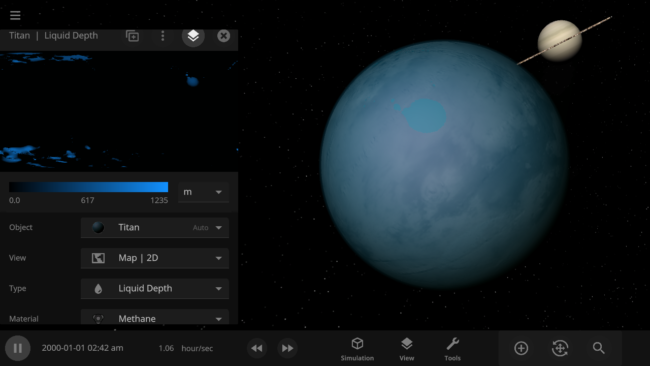
Material Phases
In our new system, all new materials can exist inside of, on the surface of, or in the atmosphere of a planet. A material’s phase will be simulated based on its temperature and pressure using something called a phase diagram. Our phase diagrams, which show a material’s state at different temperatures and pressures, are based on data taken in labs as well as geological and astrophysical models of planets. Check out the real-life phase diagram of water from Wikipedia as an example, pictured below.
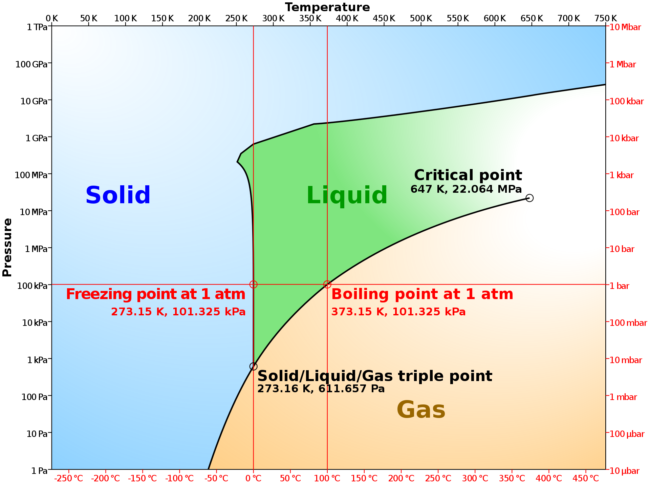
We plan to show the phase diagrams we’re using to simulate each material eventually, but right now, they’re primarily for testing. Our phase diagrams have been simplified for performance reasons but still closely reflect the scientific phase diagrams. You can compare our water phase diagram below, which has been edited for clarity, to the real-life phase diagram of water above.
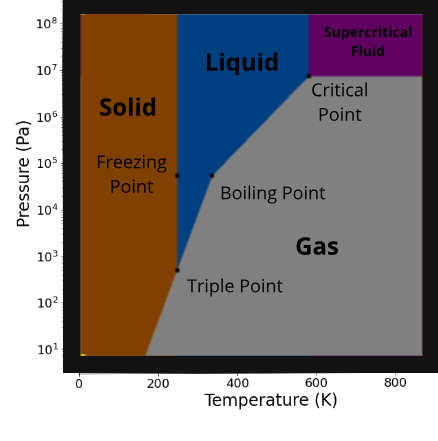
Planet Interiors
The cores of planets are hot and under intense pressure. These extreme conditions affect a material’s phase and density and thus the volume the material takes up in a planet’s interior. We’re using realistic models of planet density to compute and dynamically update planet radii from their compositions.
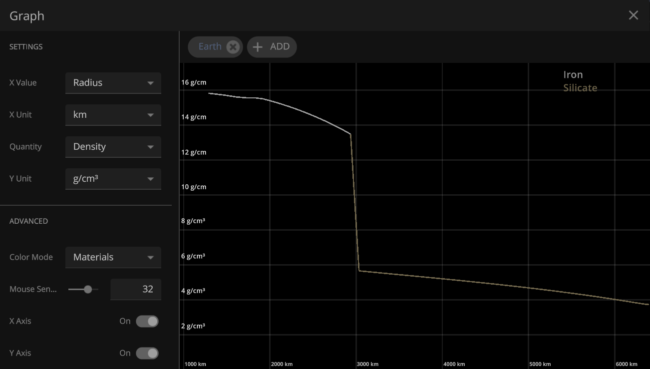

The graphs above show Earth’s density based on depth (or radius) in Universe Sandbox (top) compared to a scientifically researched model (bottom). While our in-game model is simplified, both graphs have the same shape and similar densities when compared to the radius. Comparing models allows us to check the integrity of our in-game model.
Our new composition model is more realistic but does not account for the porosity, or amount of tiny holes, of the internal structure of some objects, like the Moon. This means our model simulates some object radii slightly smaller than in real life. To account for this, we’ve added a porosity factor, which is usually an increase of a few percent, to adjust known object radii to match their real values.
The materials on the inside of planets, including iron and silicate (which are only simulated in planet interiors), do not mix together like materials on the surface or in atmospheres. Instead, we simulate planet interiors with layers of individual materials to accurately compute their radii.
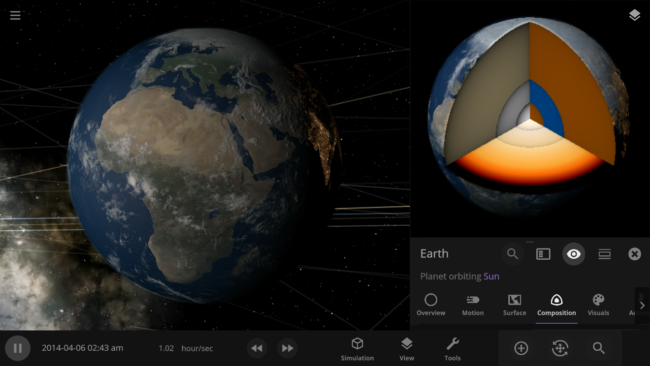
Surfaces
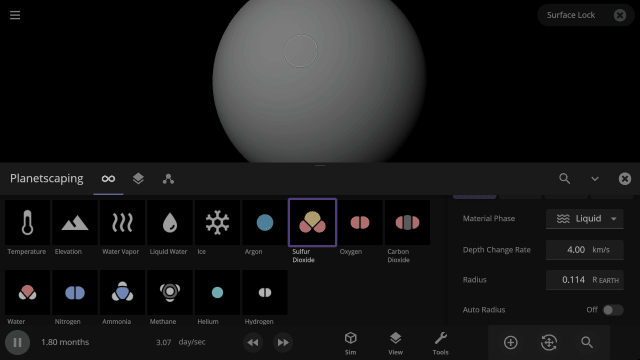
Planets can be constructed with any (or all) of the materials available in Universe Sandbox using the Planetscaping tool, Material tool, or an object’s Composition tab. The four materials with the most mass are automatically simulated across an object’s surface, similar to how water is simulated now. You’ll also be able to override this and choose which four materials to simulate across an object’s surface regardless of mass.
Surface materials freeze into ices, evaporate to become part of the atmosphere, and melt or condensate to flow together and form oceans. This allows us to realistically simulate phenomena like the lakes of liquid methane on Saturn’s moon Titan and plumes of gas evaporating into the atmosphere during collisions.
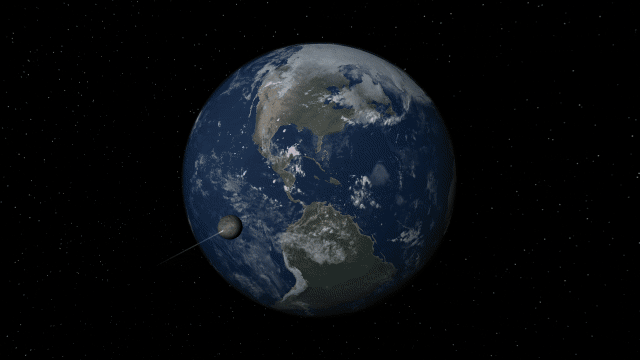
We plan to increase the number of simulated surface materials in the future, but we’re still determining the best way to do that without decreasing performance. For now, we’ve found that four materials allow for realistic simulation and fun experimentation without significantly affecting performance.
We simulate material colors on the surface and in the atmosphere based on their thickness and scientific measurements of how much light they absorb and emit. The colors of materials in each phase are also customizable across the simulation. For example, liquid water has the same base color on all planets (not including other color changes from the atmosphere or starlight).
Our material color simulation only simulates single material colors and doesn’t include any complex particles that might normally be suspended in them in real life. This means Venus and Titan may not look completely realistic yet because their atmosphere color comes from tiny amounts of complex materials not in Universe Sandbox. We are actively working on the best way to realistically simulate these colors.
Atmospheres
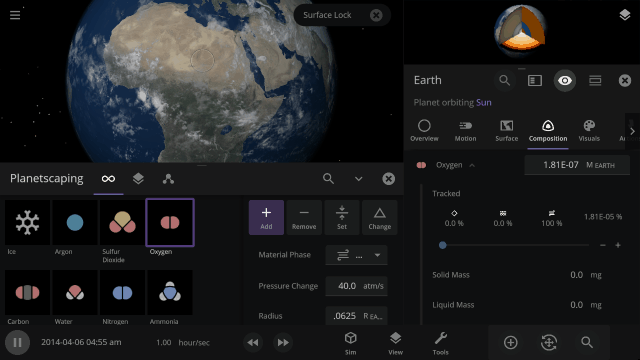
Atmosphere color, opacity, amount of atmospheric heating (the greenhouse effect), and amount of Rayleigh scattering (which determines how light scatters in the atmosphere and is what makes Earth’s daytime sky appear blue) on planets is realistically simulated from the mixture of gasses in a planet’s atmosphere.
You can create realistic Earth-like atmospheres for habitable planets and oppressive Venus-like atmospheres just based on their compositions. Currently in Universe Sandbox, this is only possible by manually changing a planet’s Infrared Emissivity, which can increase the amount of heat the atmosphere of a planet retains.
The color and opacity are simulated locally throughout a planet’s atmosphere. If you add lots of oxygen in a single region of a planet’s atmosphere, it will get more opaque and change color based on the amount of oxygen in just that area.
New Minimum Operating System Requirements
To add new materials and eventually simulate more than four materials across planet surfaces, we will be dropping support for Windows 7 when this feature is released.
While it is never fun to have support dropped, this will affect just 0.25% of our users and will allow us to leverage newer computational methods to increase the performance of our surface simulation.
We’ll make sure all users who are affected by this change will be able to access the final version of Universe Sandbox with Windows 7 support.
What’s Still Being Worked On?
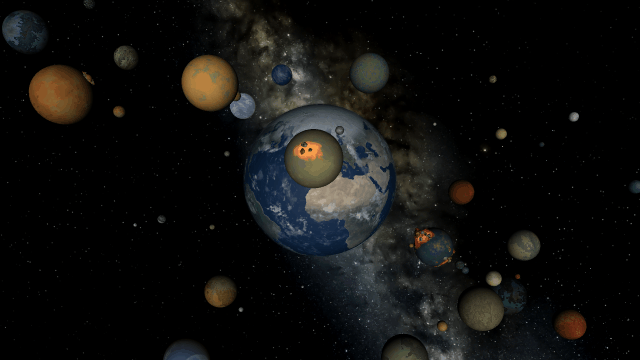
We’ve been prioritizing designing the properties, data views, and tools for you to easily construct atmospheres, build and terraform planets, and track these materials, but the interface for using them is still a work in progress.
Planets saved in previous versions of Universe Sandbox will only have the previous four materials, which will look and behave differently in our new composition system. Imagine Earth with a pure hydrogen atmosphere – not very realistic. We’re still trying to make this process as smooth as possible, and eventually, you’ll be able to easily update your planet’s atmosphere to be similar to Earth, Venus, Mars, or Titan.
And like any new feature, there may be bugs we have yet to find and fix – and you can help!
Try the Terraforming | Update 34 preview right now!
Eight new materials and our new composition system are now available for testing and feedback. Learn how to opt-in to a preview version on Steam:
https://universesandbox.com/support/previewversion
Let us know what you think and show us what you do with these new materials!
Join our community discussions on our Steam Forum and our official Discord community.

Universe Sandbox for Mobile | Development Challenges | Update 2
Aug 23rd
Bringing the complete Universe Sandbox experience to mobile is an exciting and challenging project, and while development was stalled while hiring a new user interface engineer, we are back on track! While we still don’t have a release date for Universe Sandbox on mobile, we want to share our recent progress and current obstacles.
For an overview of our plans for Universe Sandbox on mobile devices, you can read our first Mobile DevLog.
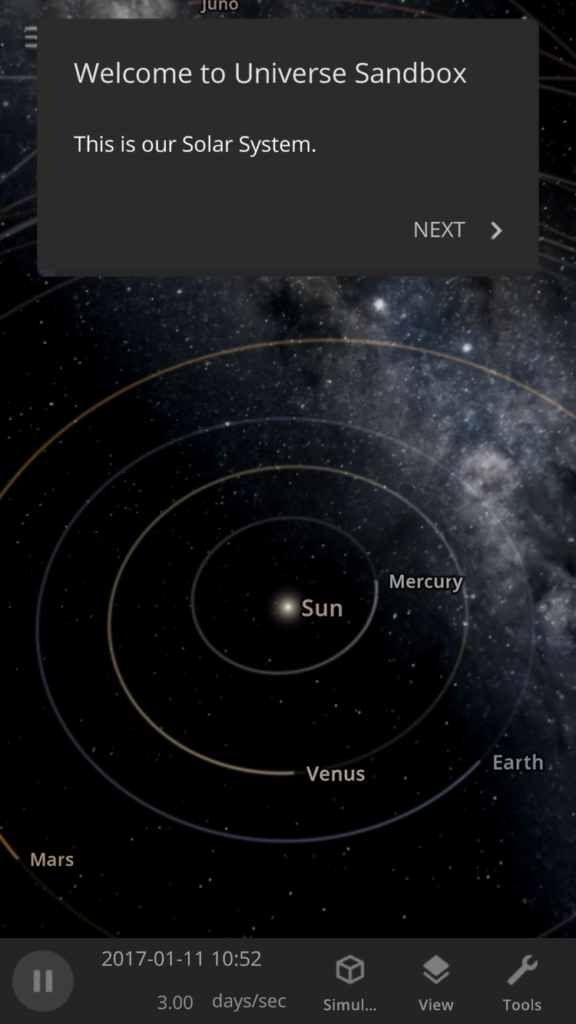
Pocket-Sized Complexities
We’ve been thinking about Universe Sandbox mobile for a long time and have been developing our panels and buttons to be easy to view and use on small screens for years. In fact, Universe Sandbox mobile is built from the exact same code as the version you already know and love, so it will have the same features and user interface as the desktop experience.
This shared codebase means you can enjoy any new features and improvements we add to Universe Sandbox on any device, whether you’re on a desktop, laptop, VR headset, phone, or tablet.
While these are seemingly simple goals, they create complex design challenges:
- How to automatically arrange panels and adjust your view so you can focus on controlling the simulation, not having to manage the user interface
- Switching between multiple panels, like an object’s properties, data views, and guide instructions, on small screens in landscape and portrait modes
- Overhauling our simulation tools (like explode, laser, and planetscaping), to adapt to all screen sizes
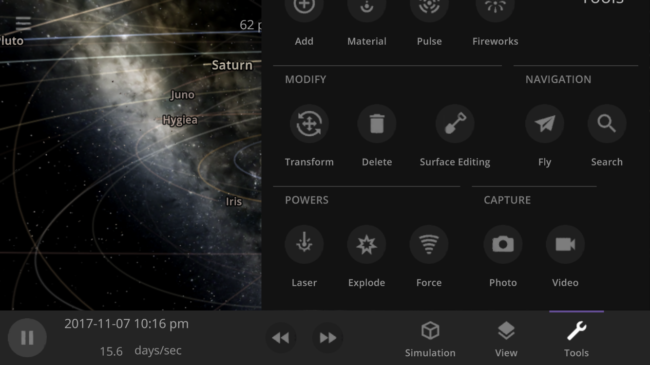
Under New (Layout) Management
While most other simulators and games have a different user interface for their mobile and desktop versions, we want ours to use the exact same interface for all platforms. We think we’re among the first to do this, but if you know of another or have done this with your game, please let us know! You can see what Universe Sandbox mobile might look like right now (including why we haven’t released it yet) by resizing the Universe Sandbox window on your computer to the size of your phone (since our user interface dynamically responds to your window size).
While we are still making performance improvements so Universe Sandbox can run smoothly on phones, our primary obstacle in mobile development is ensuring our interface is usable on a small touch screen like a phone. We’ve started tackling it by designing a system to intelligently hide and reveal panels as they open and close, which we’re calling our Dynamic Layout System.
While creating this system will take time, it should allow future improvements and new features to work in Universe Sandbox without any extra development, regardless of whether you’re playing on mobile or desktop. That means we’ll have more time to work on new features instead of spending time implementing the same feature in two different ways.
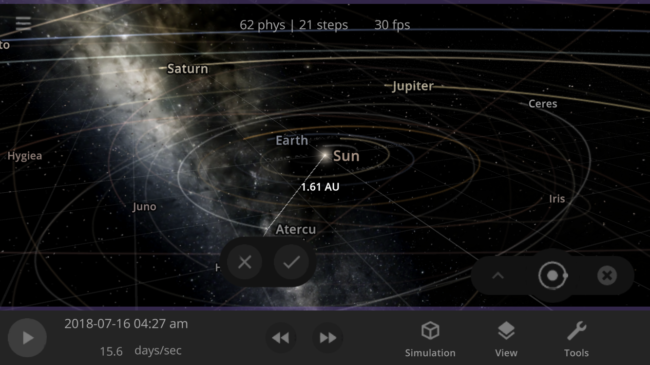
Current Progress
We’ve been researching the best way to create this dynamic panel management system and have made significant progress implementing it within Universe Sandbox.
There’s still other work to be done, and we do not have a release date or official price for mobile, but we’re still planning on it being a one-time paid app with no ads or in-app purchases.
We have yet to finalize the minimum device requirements for the mobile version, but it will likely require a modern device with decent specs. We will share more about hardware requirements as soon as we finalize them.
Taking a feature-rich, user-interface-heavy desktop game and porting it to mobile presents many challenges, but we are excited to tackle them and create an experience unlike any other at your fingertips.
To receive updates about mobile, like this one, sign up for our mailing list:
http://universesandbox.com/mobile/
Join our community discussions on our Steam Forum and our official Discord community.

Gravity Simulation Upgrade | Update 33
Aug 16th
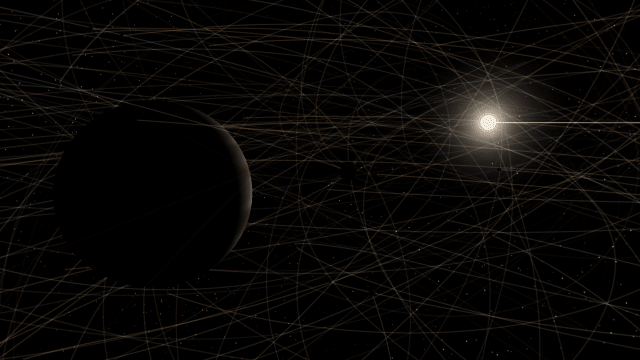
If Update 33 does not download automatically, follow these update instructions. If you don’t own Universe Sandbox, you can buy it via our website.
Gravity Simulation
We’ve completely overhauled our gravity simulation to increase accuracy, stability, and overall performance. Run simulations at higher speeds than ever before while maintaining gravitational accuracy.
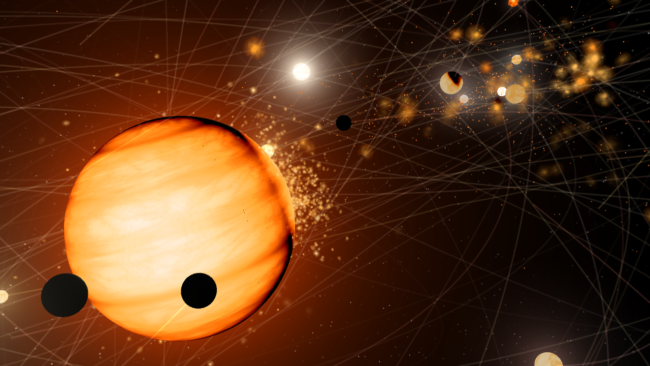
Many simulations can now be run at noticeably higher simulation speeds. Try increasing the simulation speed of the Solar System simulation or your own custom simulation.
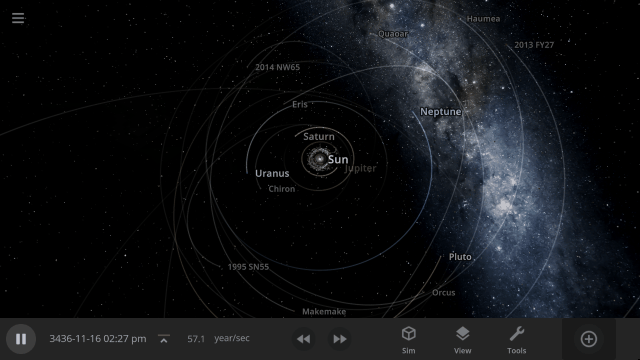
Before
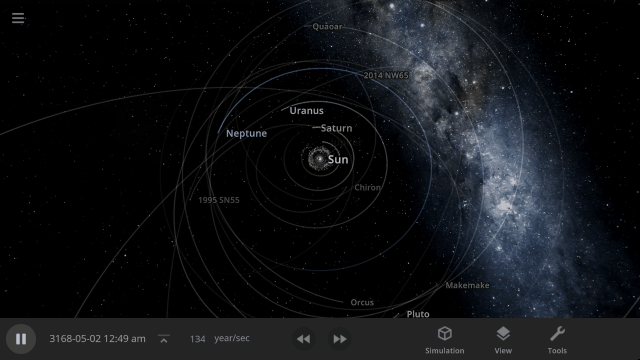
After
The Hubble Space Telescope used to crash into or fly away from Earth at simulation speeds greater than a couple days per second. Now it maintains a stable orbit at much higher simulation speeds.
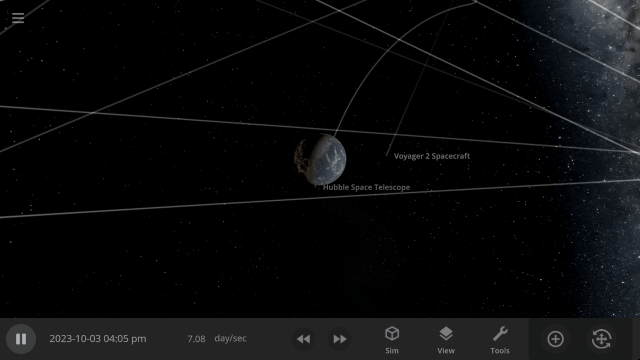

Choreography simulations, where moons are distributed evenly over a pre-computed path creating a unique design, are much more stable and create the desired patterns, like this fish, before becoming gravitationally unstable and falling apart, as expected.
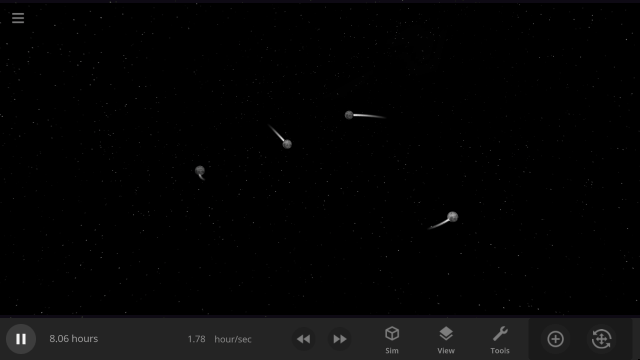

We’ve also added more controls so you can fine-tune the balance between maximum simulation speed and gravitational accuracy. Learn more in our updated guide
Guides > Tutorials > Advanced Simulation Speed Controls
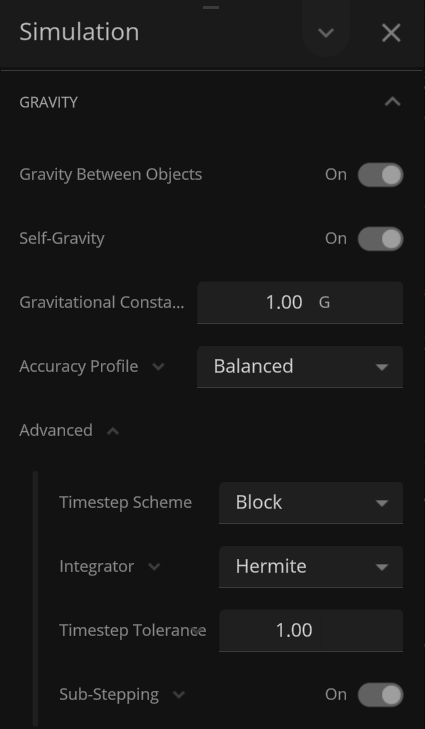
More Highlights
Small objects colliding with gas giants now create more realistic impacts with smaller, gradually growing impact areas
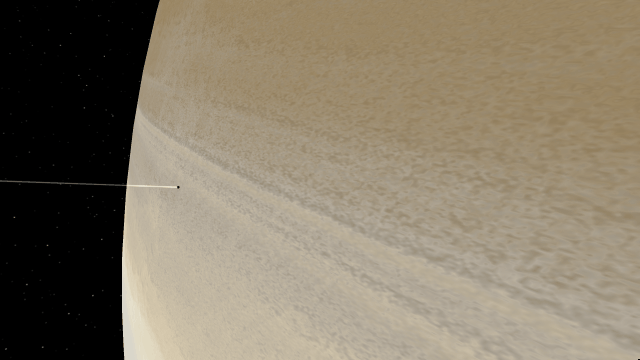

Object selection has been completely rewritten. It’s now much easier to select objects in crowded simulations with lots of dust clouds and fragments.
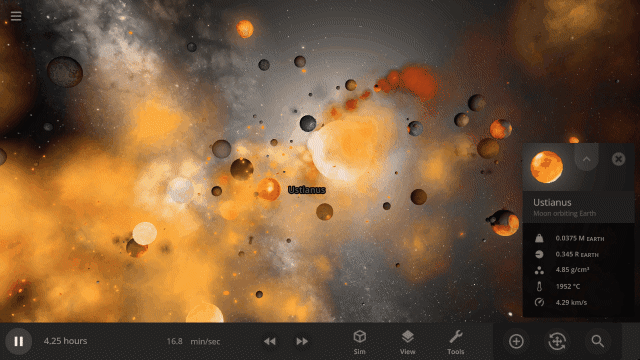
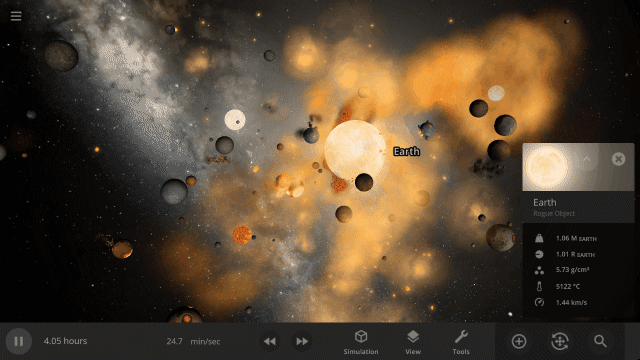
Check out the full list of What’s New in Update 33
Please report any issues on our Steam forum, on Discord, or in-game via Home > Send Feedback.
The Future of Universe Sandbox on Linux
Jul 12th
Our latest release, Update 32.3, will be our last with a native Linux version of Universe Sandbox. Future Linux versions of Universe Sandbox on Steam will be powered by Valve’s Proton, software built into Steam that allows Windows games to run on Linux.
If you are a Steam Linux player, no action is required to continue playing Universe Sandbox. This change should be seamless.
We know this may be disappointing, but after internal testing and user feedback, we have found that playing Universe Sandbox through Proton on Linux machines provides a better overall experience. Valve has put a tremendous amount of energy into developing Proton, which has made this decision much easier. As a small indie team, the upkeep of a Linux version was disproportionately high compared to the size of the Linux player base (just over 0.5% of all players).
Due to the limitations of the Steam platform, we can no longer provide access to older native Linux versions. If you are a Steam player who needs access to the last Linux native version (Update 32.3), please contact us.
If you are a GOG or Itch player, older releases will remain available in their respective download sections. We recommend GOG and Itch players on Linux use either Heroic Games Launcher or Lutris for future versions.

Grand Collision Unification | Update 32.3
Jun 29th
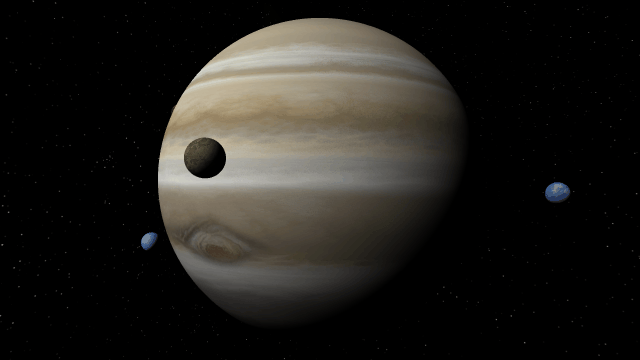
If Update 32.3 does not download automatically, follow these update instructions. If you don’t own Universe Sandbox, you can buy it via our website.
We’ve combined our two previously separate collision methods improving collisions so shockwaves now realistically eject fragments as they spread across gas giants during collisions. Interface panels, such as graphs, data maps, and object properties, are now remembered when you open saved simulations. We’ve also added new astronomical discoveries to explore, like the galaxy-sized detector used to find new evidence of supermassive black holes.
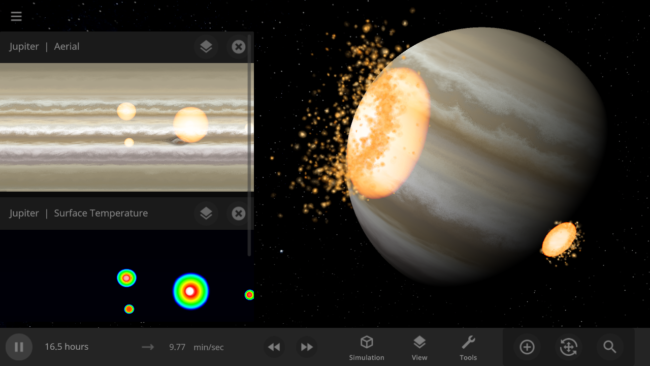
Unified Collisions
Collisions are more realistic, with shockwaves propagating across gas giant surfaces and fragment ejection direction based on impact angle with our new unified collision system. This new collision solution combines our two previous separate collision methods.
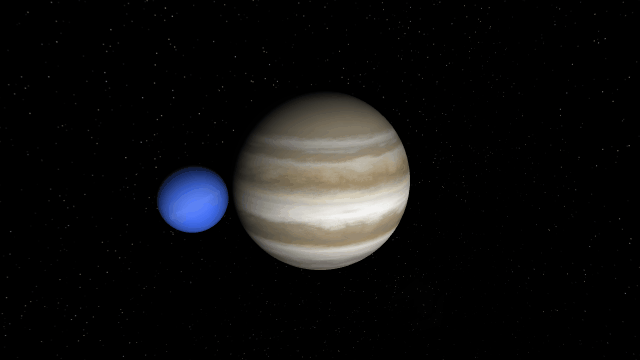
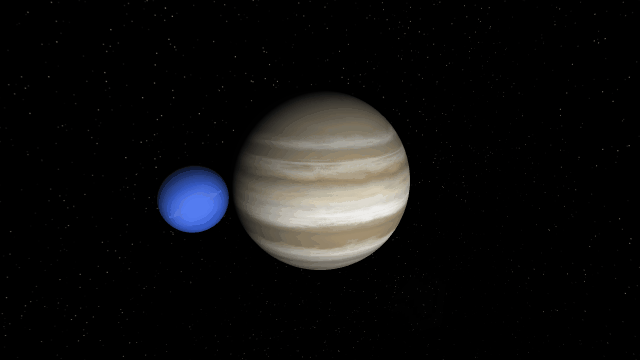

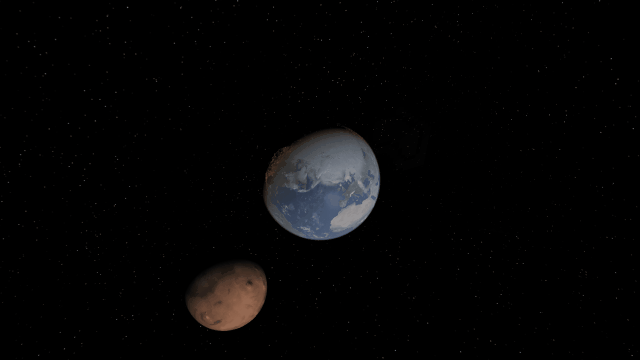
Saving Your Interface
Pick up right where you left off with the properties panel open, or include a temperature graph in a shared simulation to show a planet heating up from a close encounter with a star. Saved simulations now remember the state of the interface panels. See it in action in
Open > Core > A Tidally Heated Habitable Moon or Tidally Locked Earth
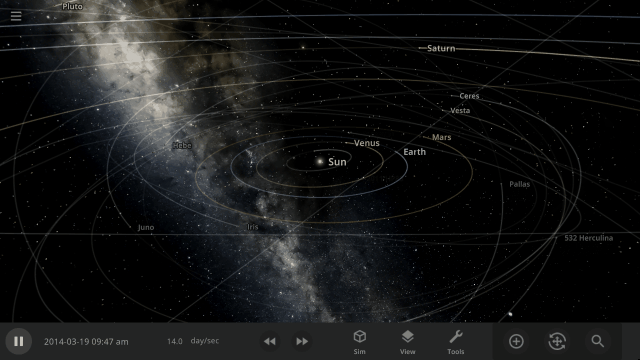
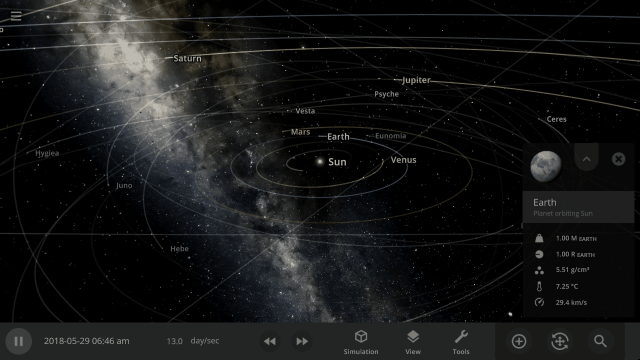
Searching for Supermassive Black Holes
On June 28, 2023, evidence for a signal generated from all supermassive black hole pairs from across the universe was announced by the North American Nanohertz Observatory for Gravitational Waves. Explore the galaxy-sized detector they used and learn how they found this evidence in our new guide
Guides > Discoveries > Searching for Supermassive Black Holes
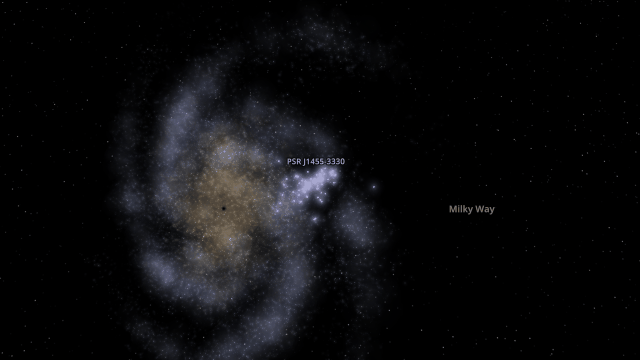
More Highlights
See the dwarf planet Quaoar’s newly discovered rings in the new simulation
Open > Solar System > Quaoar with Rings
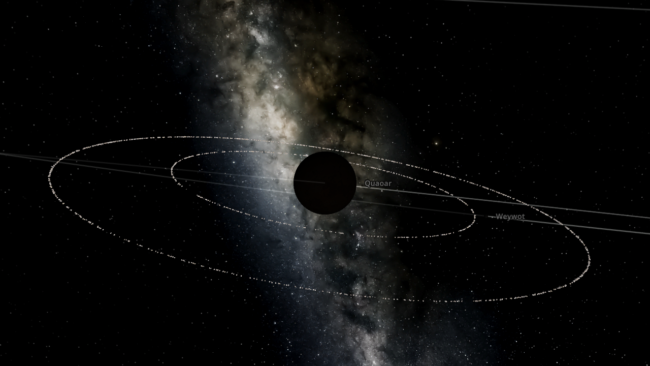
We’ve also added a simulation of the dwarf planet Haumea’s rings, which were discovered back in 2017, in the simulation
Open > Solar System > Haumea with Rings
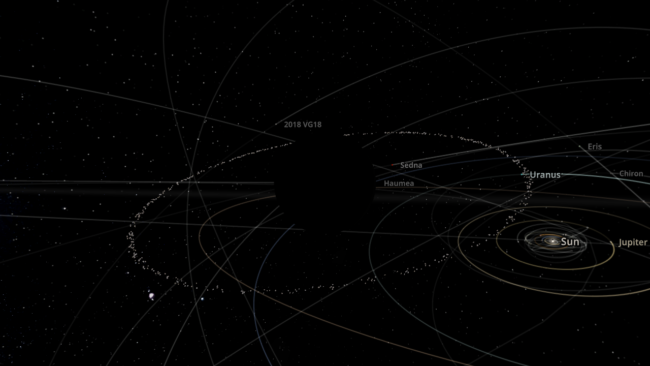
Manipulate the temperature of the universe and learn about the cosmic microwave background, a type of faint radiation spread across space, in our new guide
Guides > Science > Cosmic Microwave Background
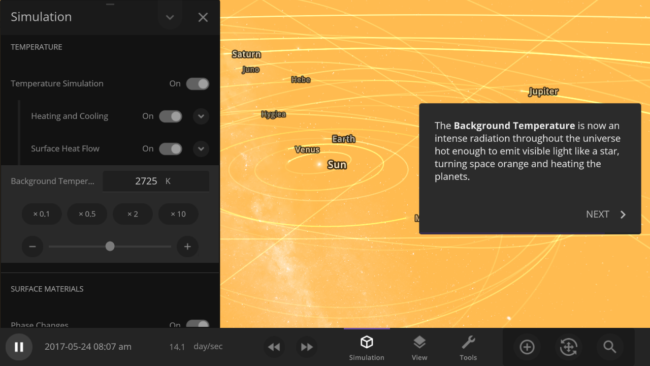
Display settings have been updated to include more options for exclusive fullscreen, fullscreen borderless, and windowed resolutions
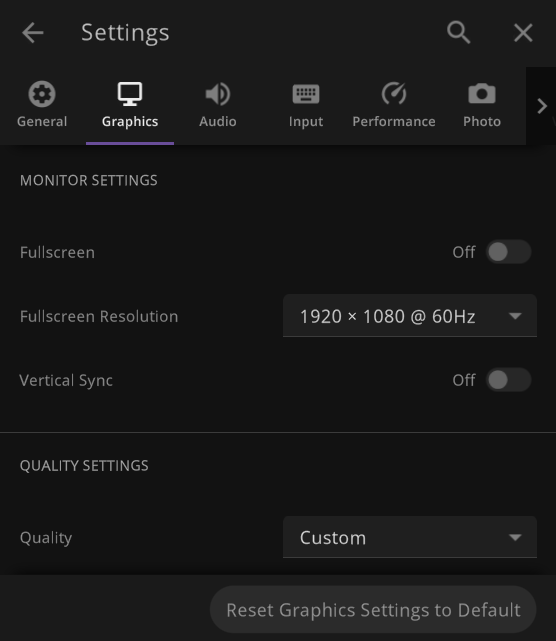
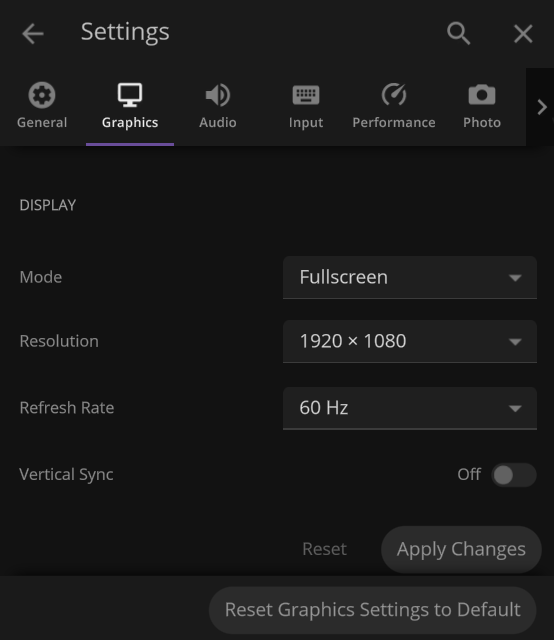
Additional Actions have been added to the Properties panel of objects so you can easily Fly To, Follow, or Land on objects
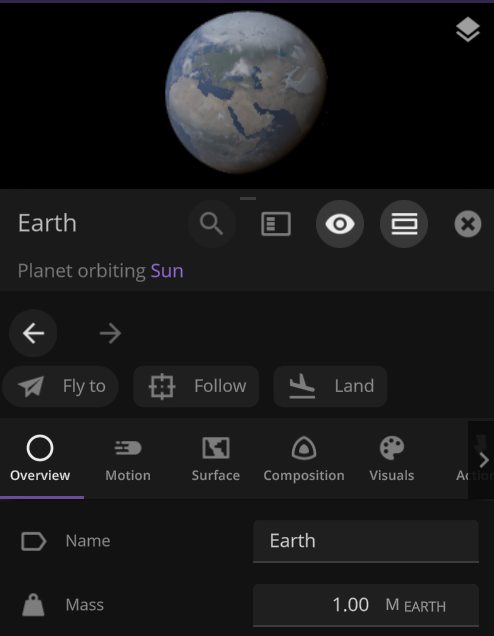
Default temperature unit can now be changed to °F, only °C, or only K under
Settings > General > Temperature Units
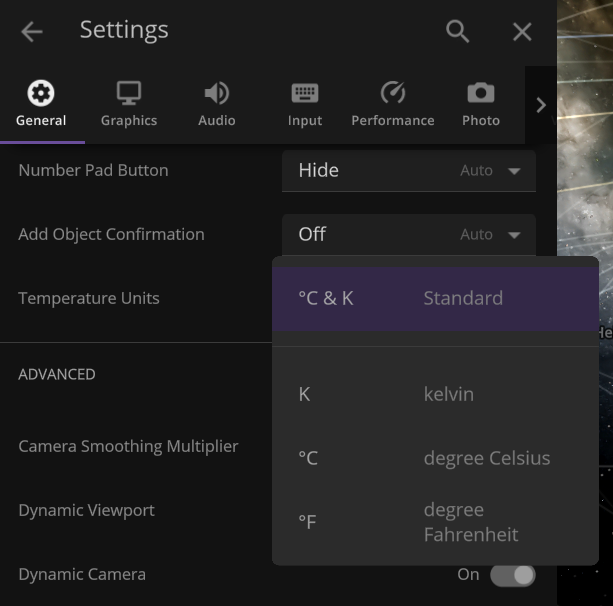
Check out the full list of What’s New in Update 32.3
Please report any issues on our Steam forum, on Discord, or in-game via Home > Send Feedback.
